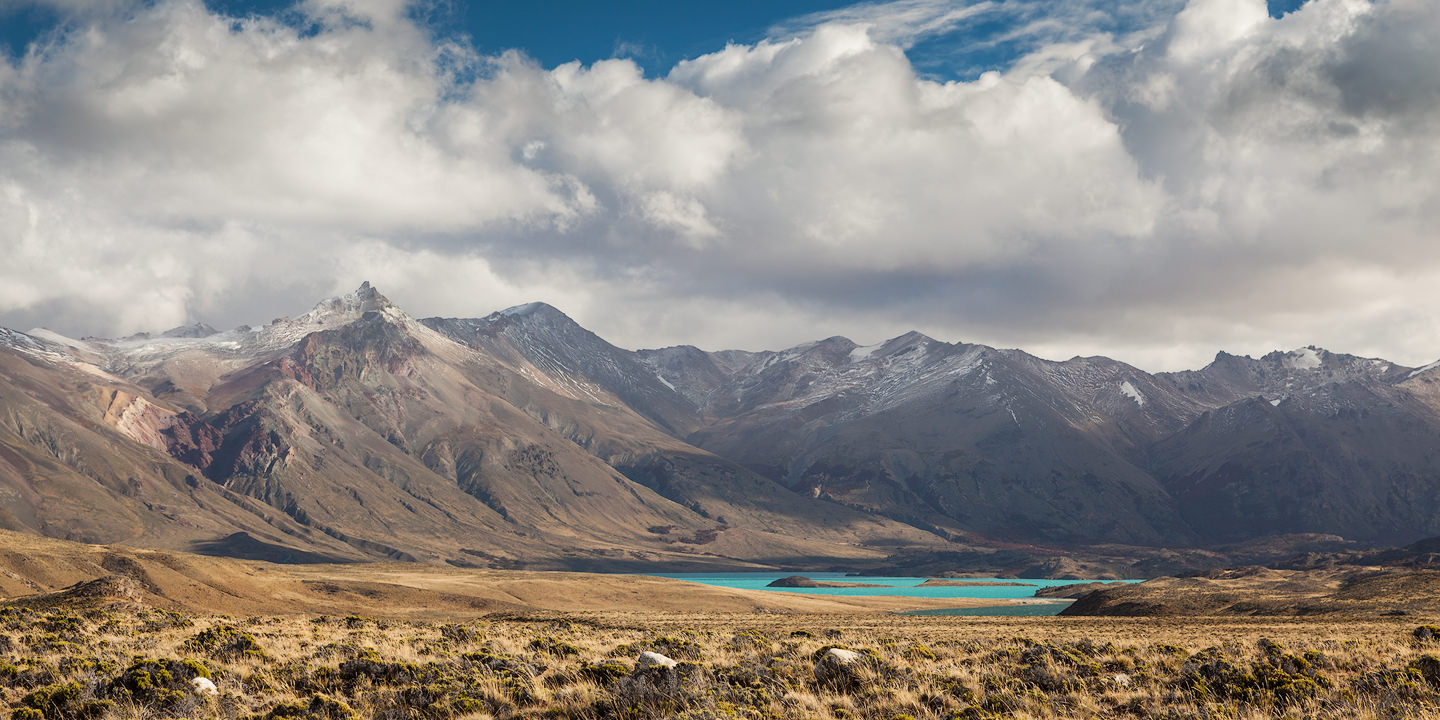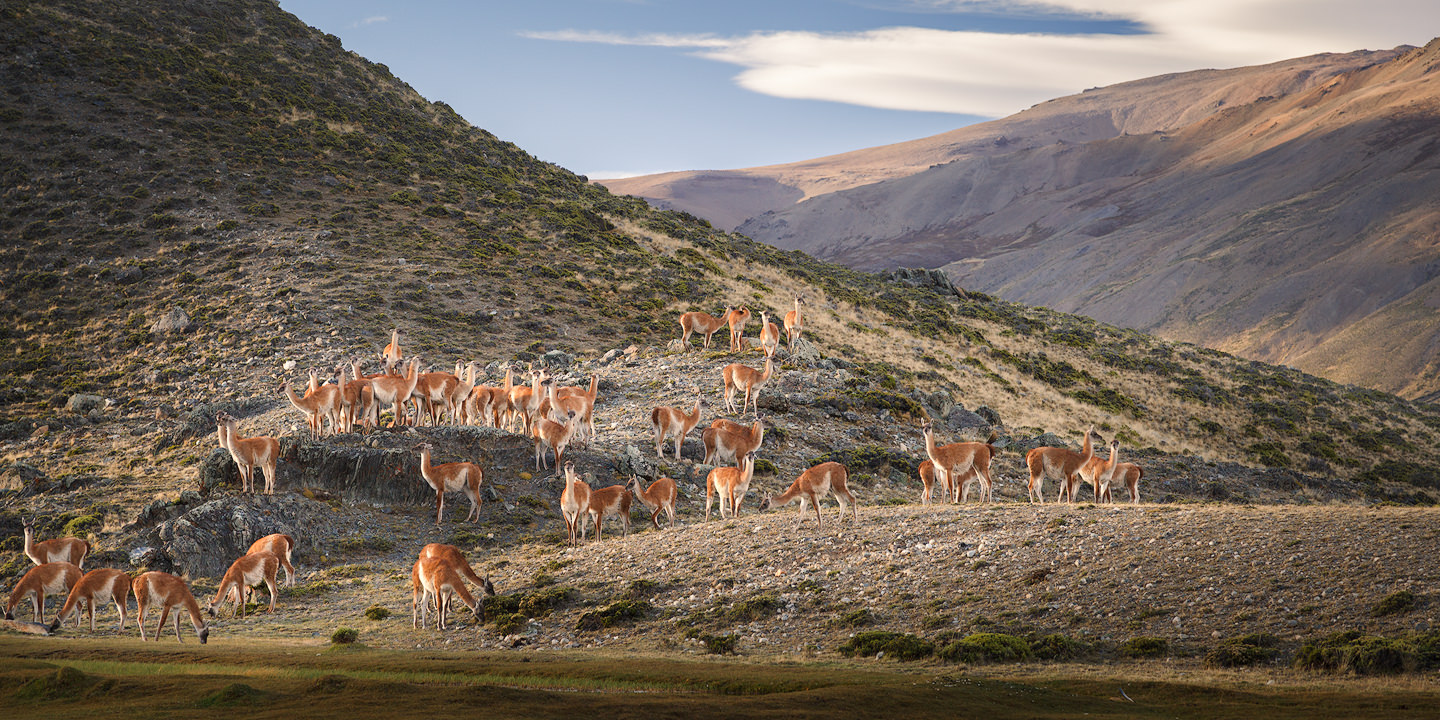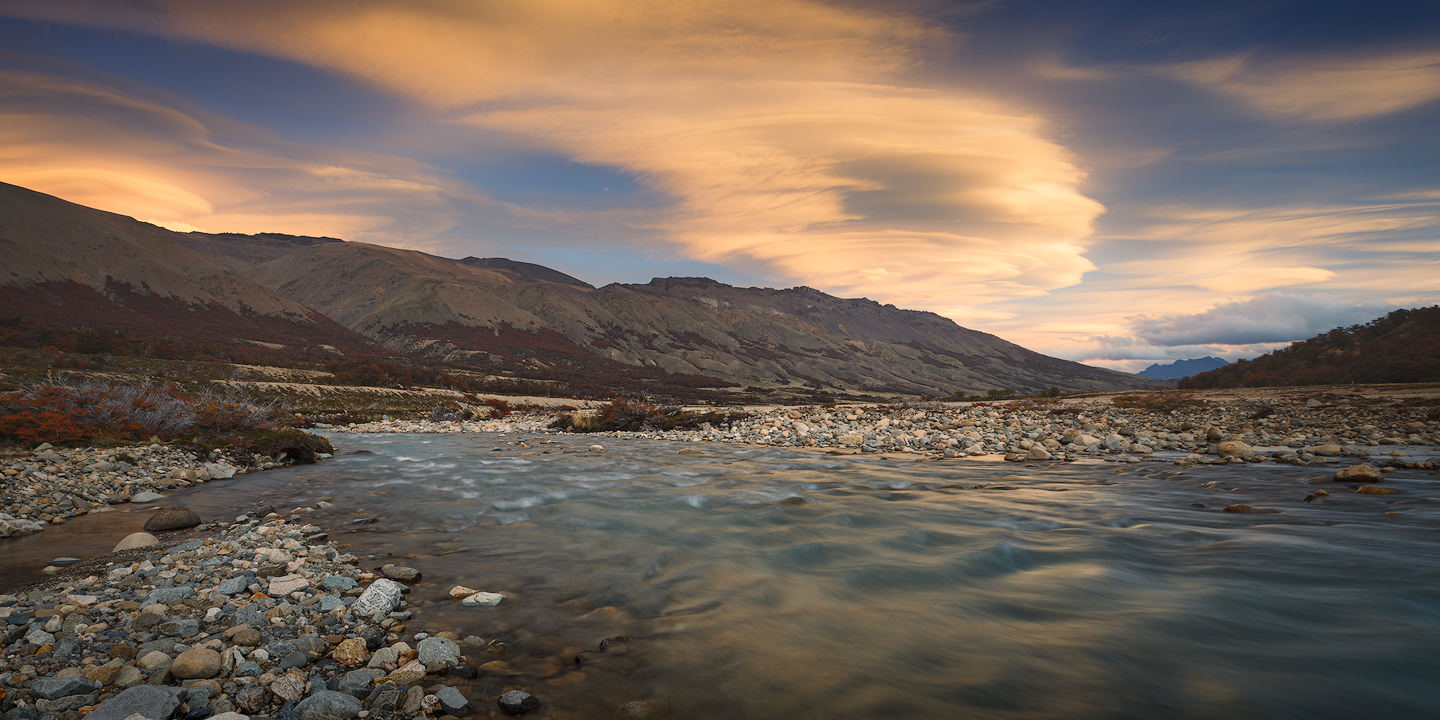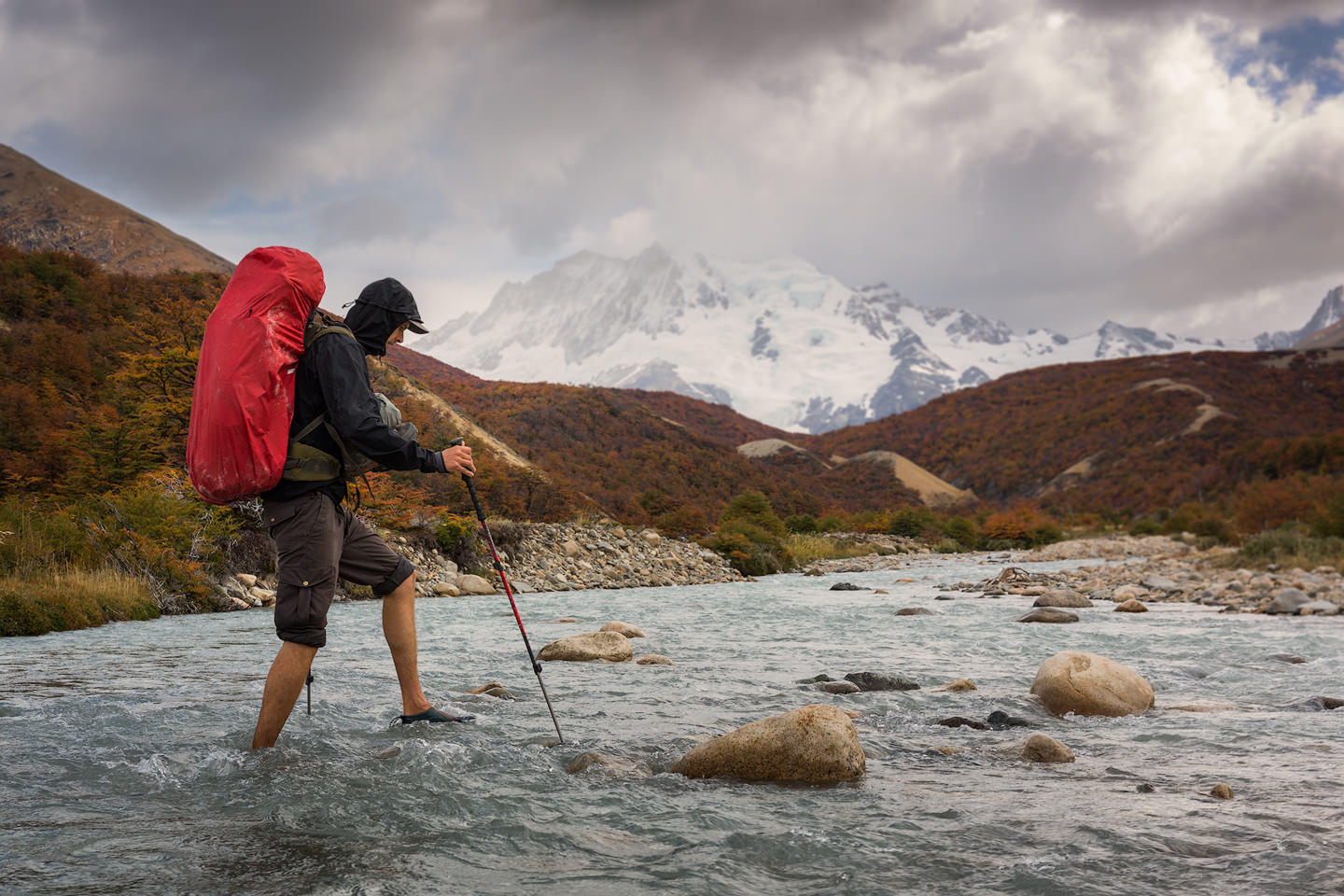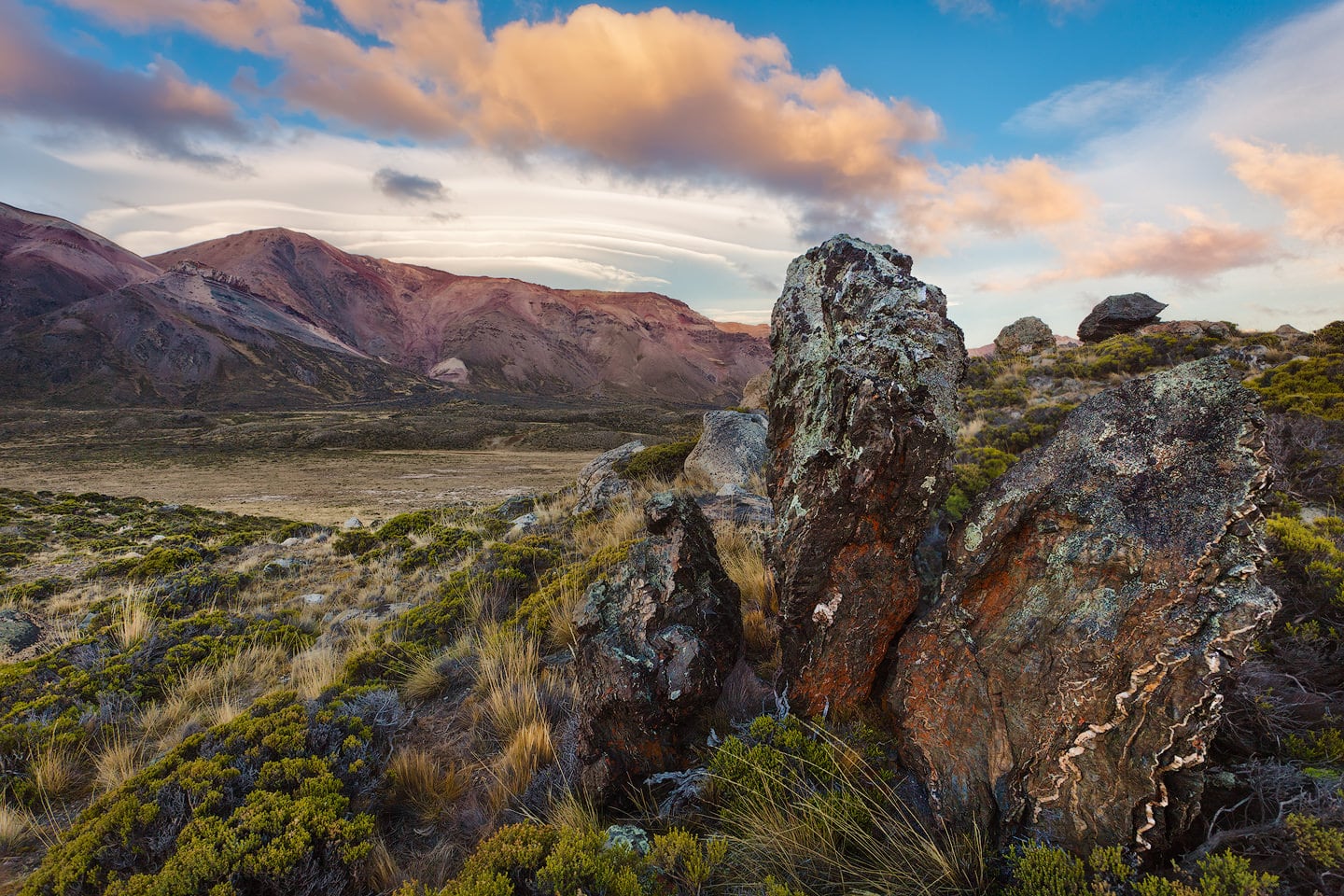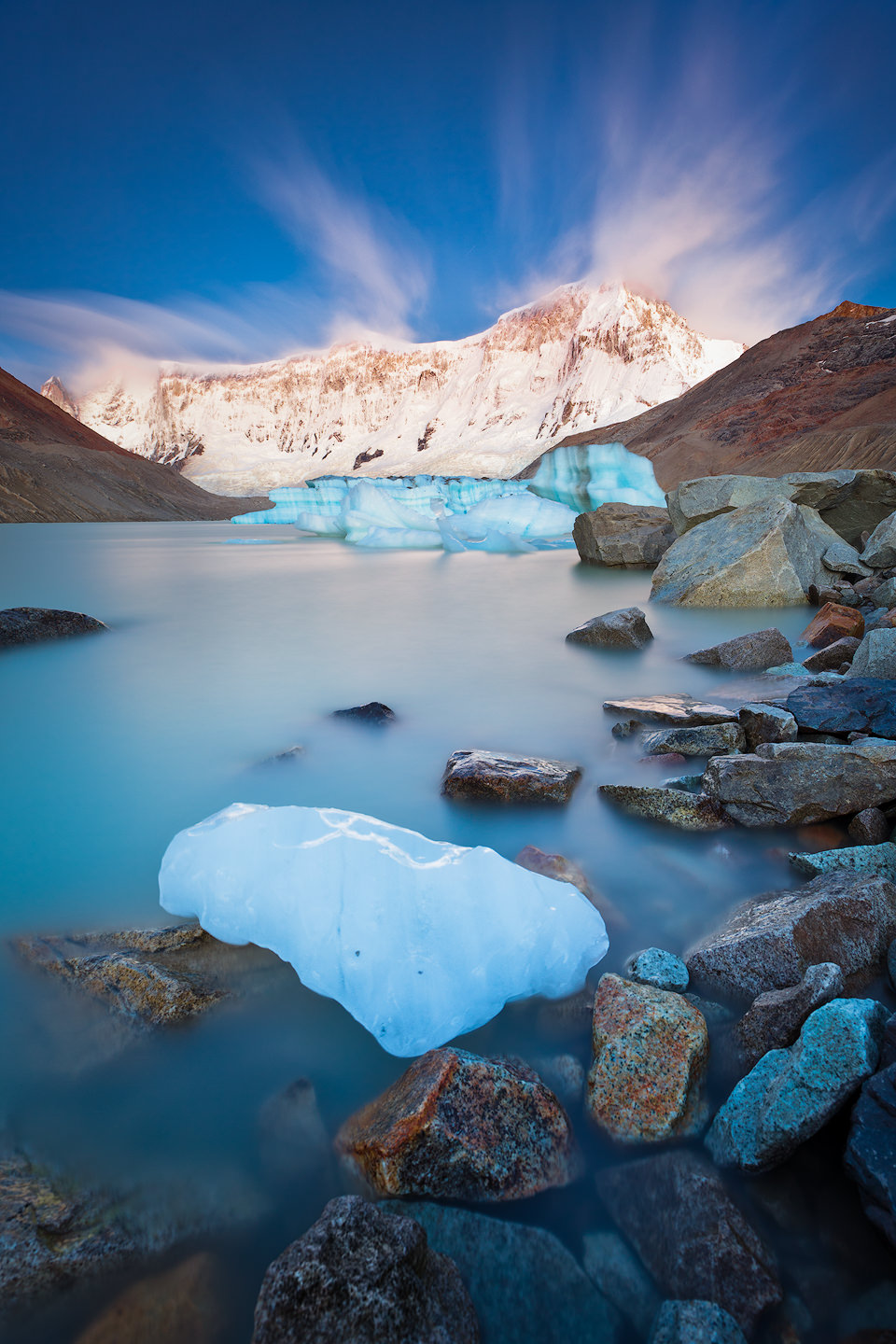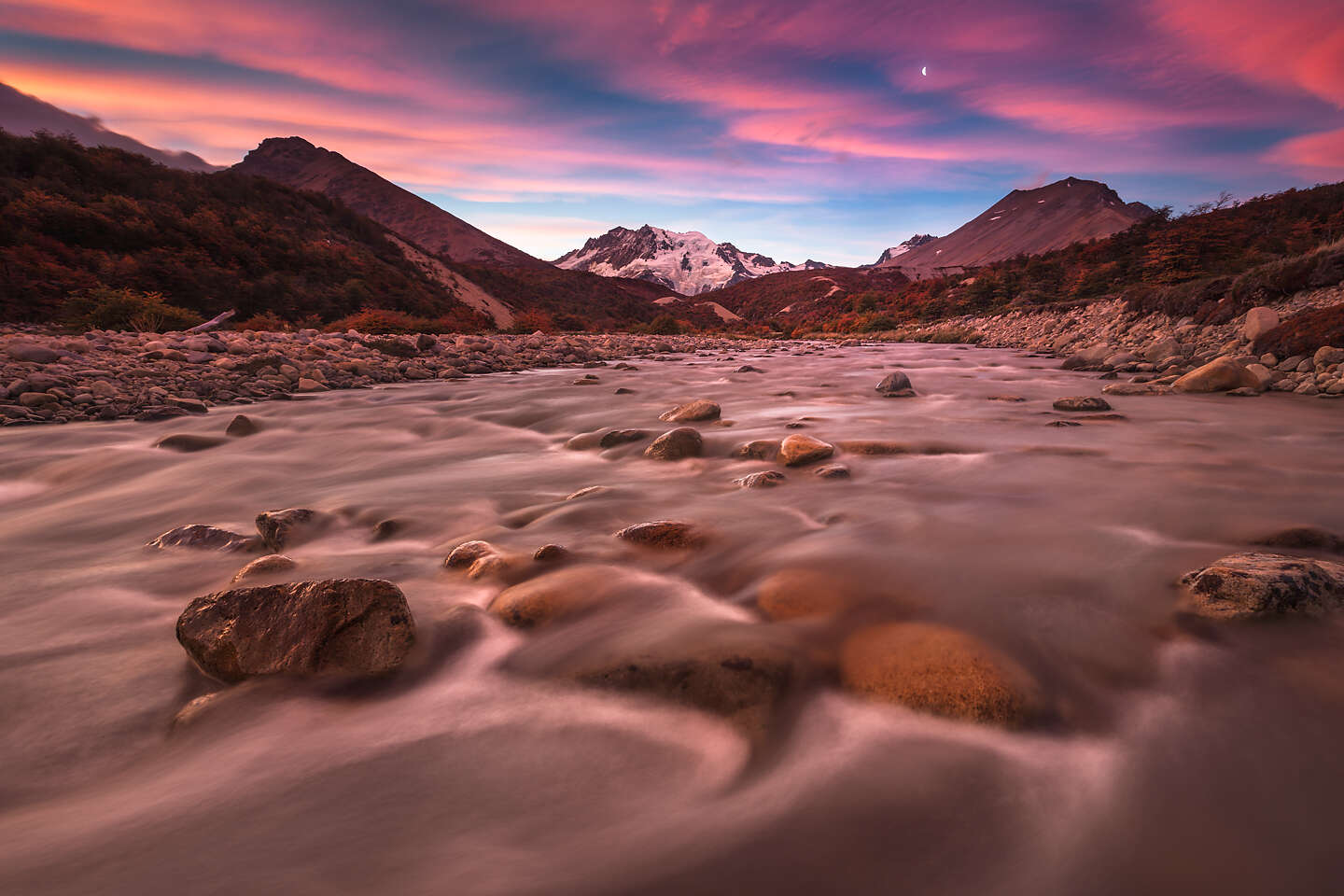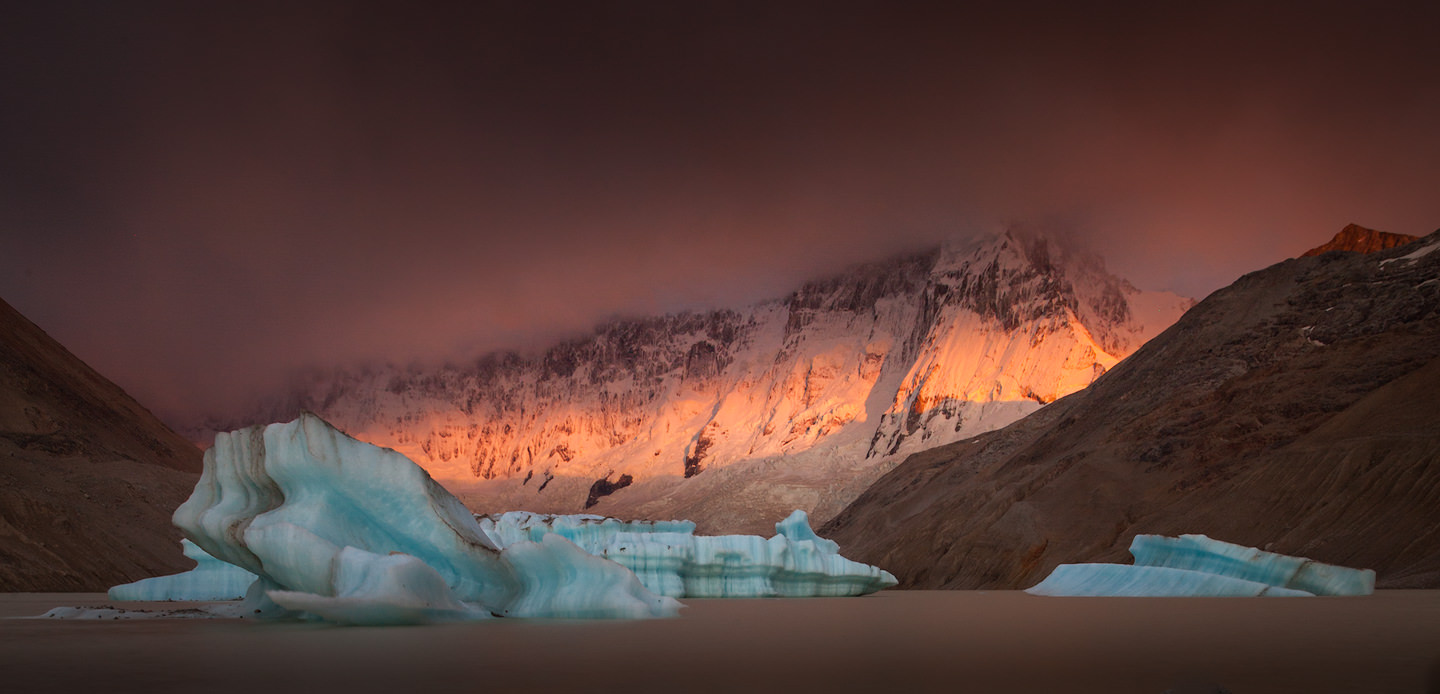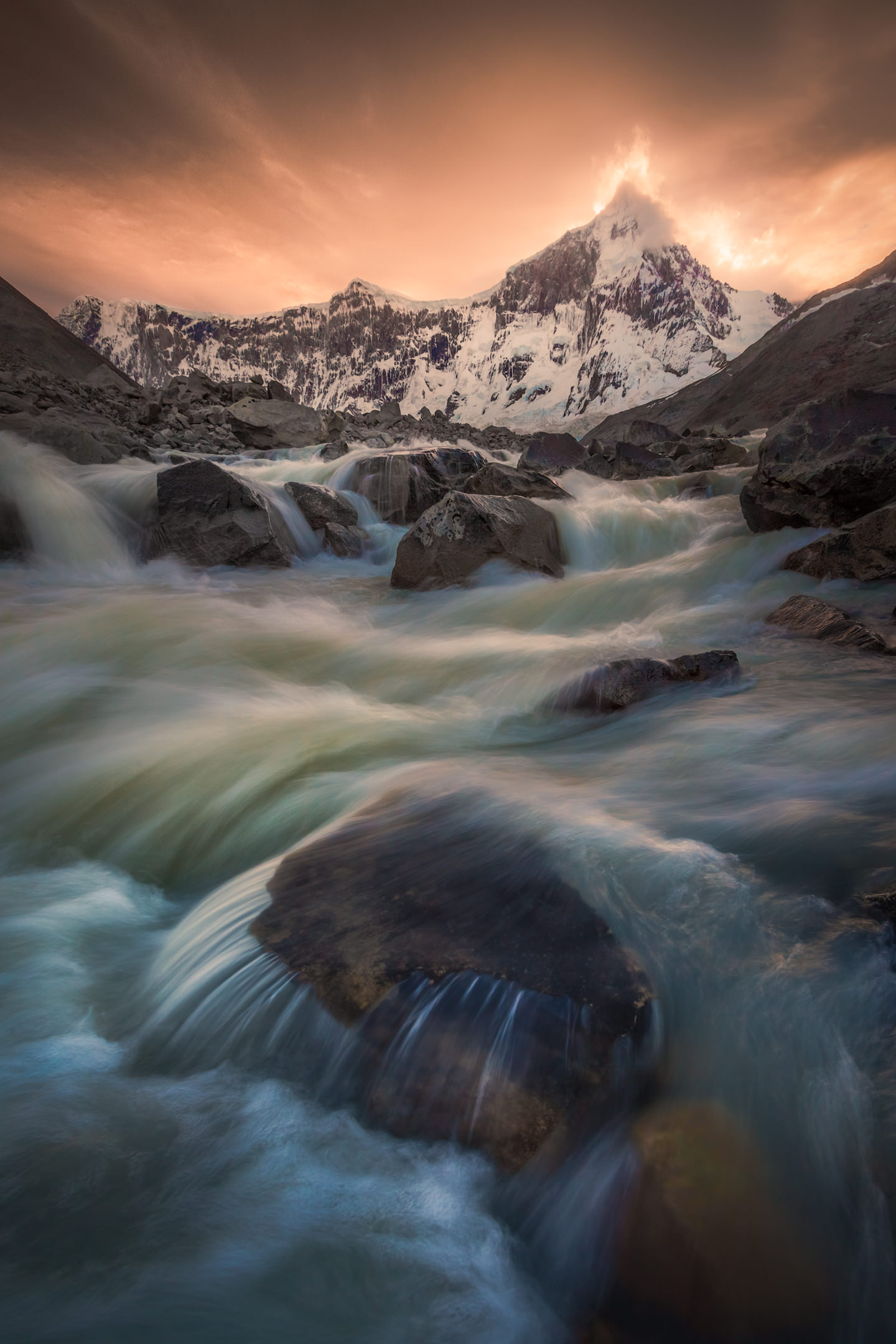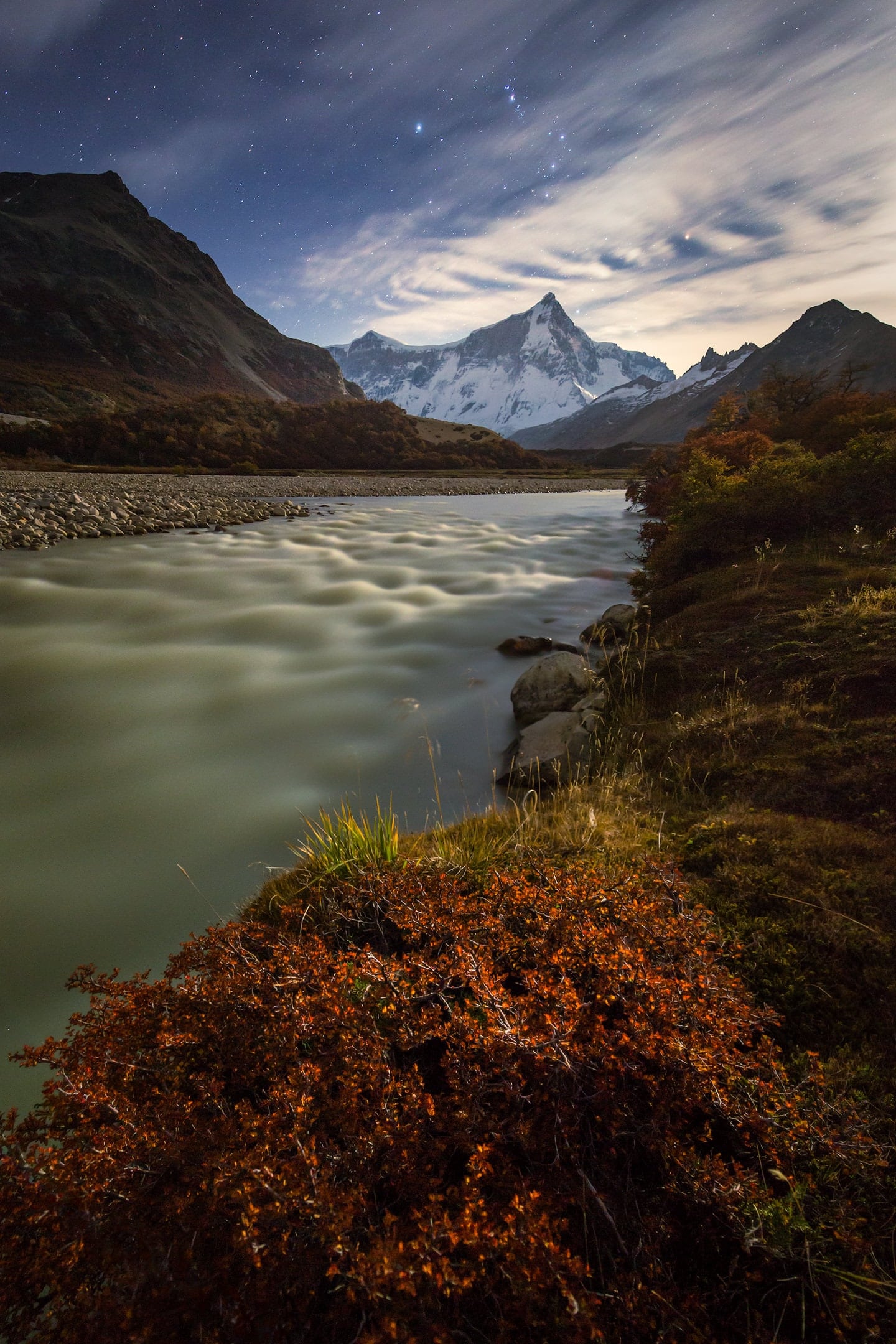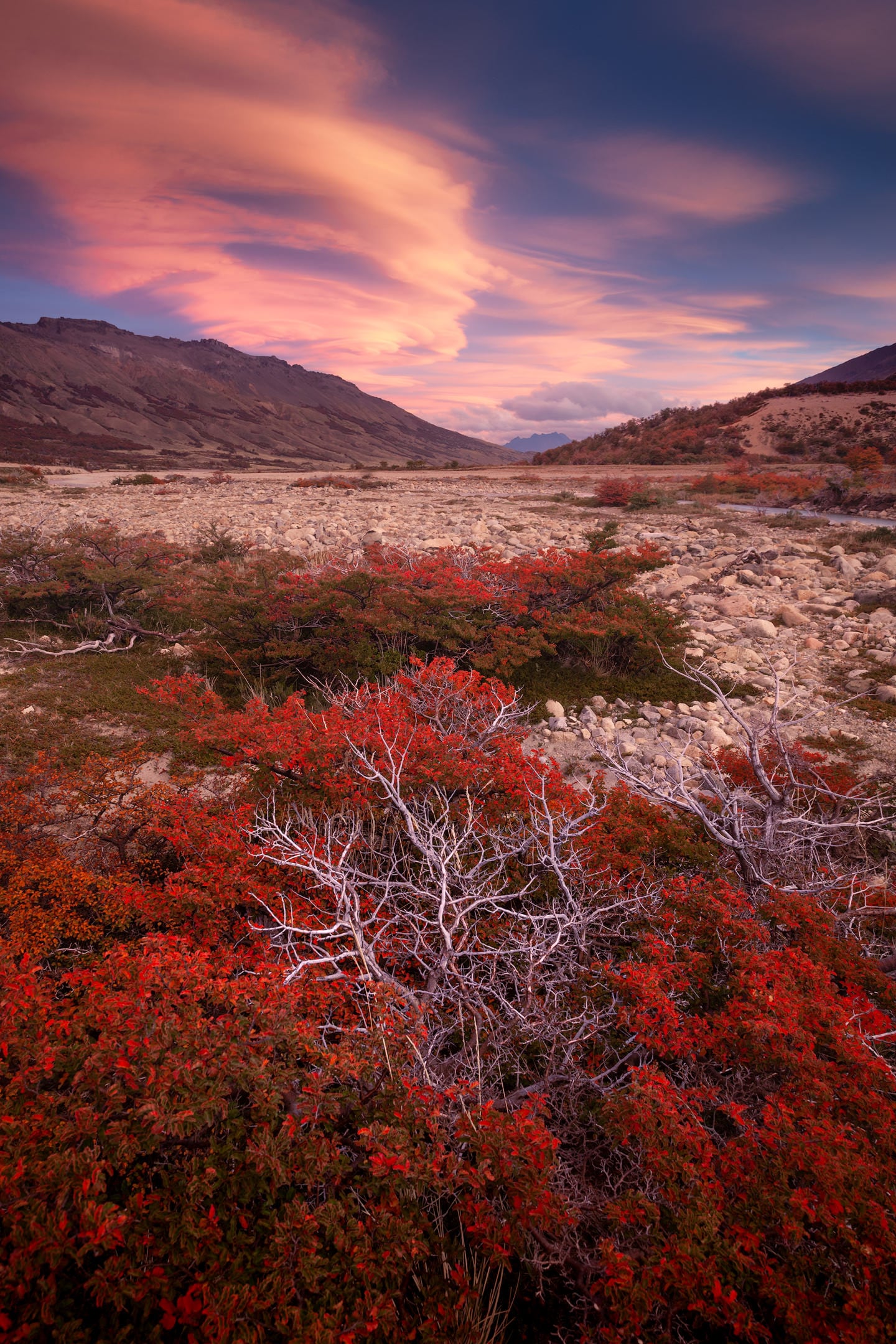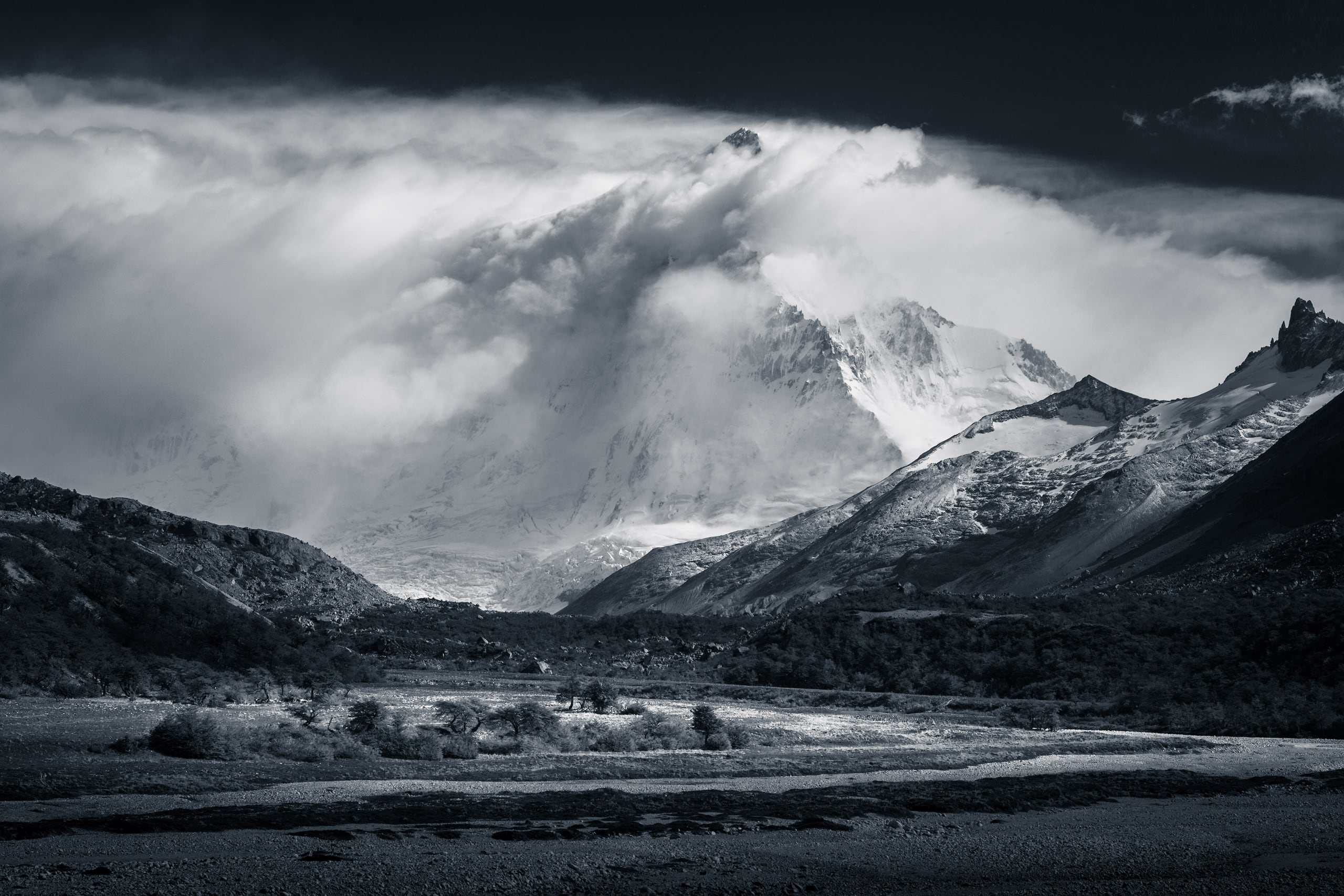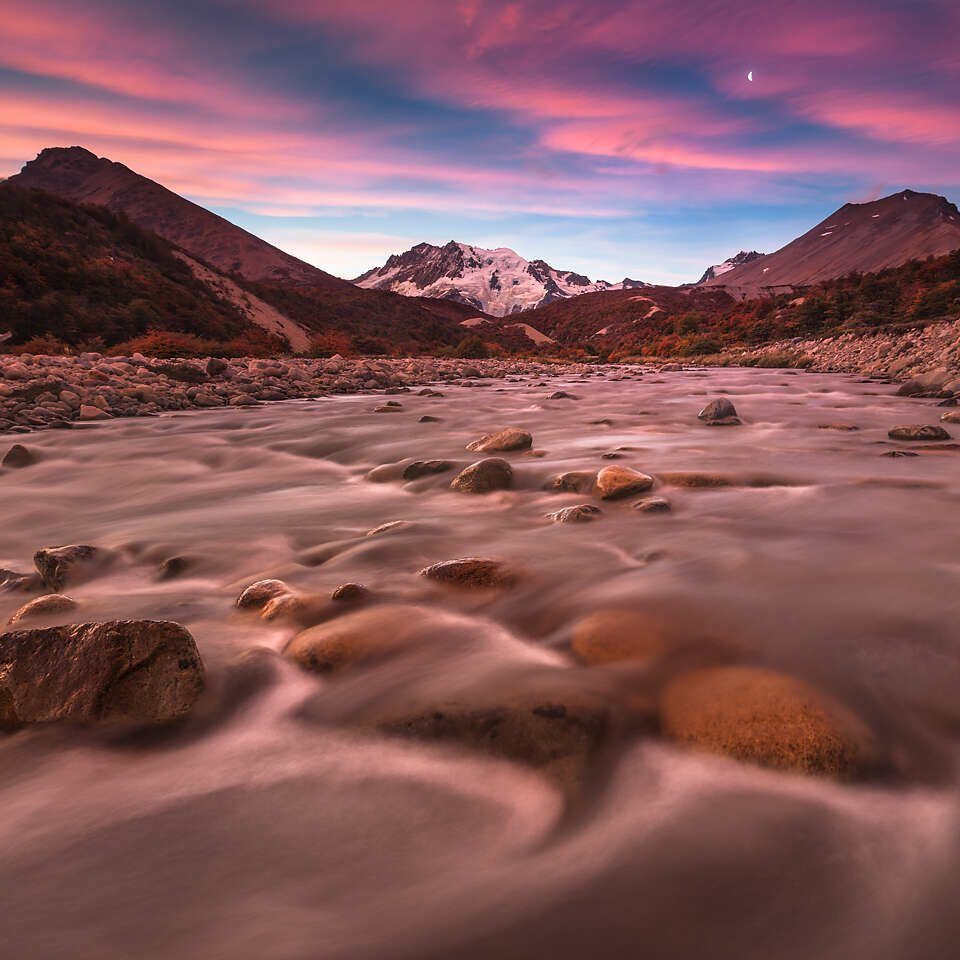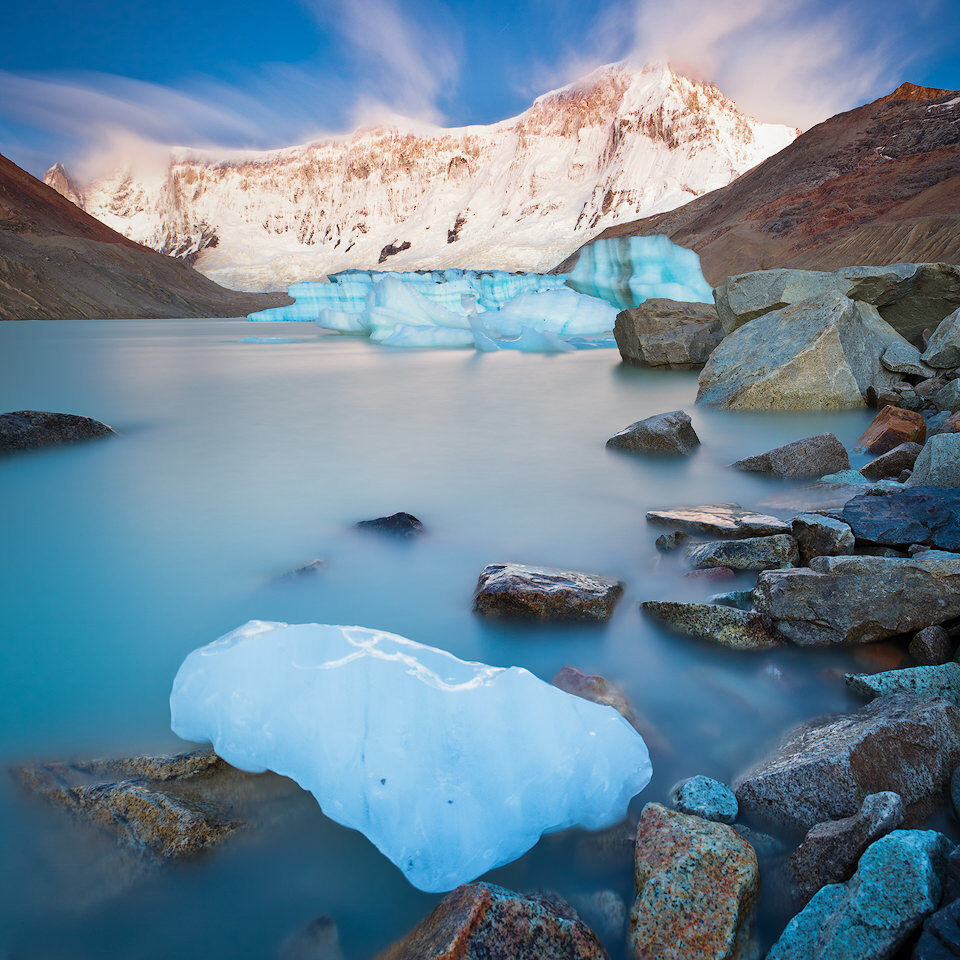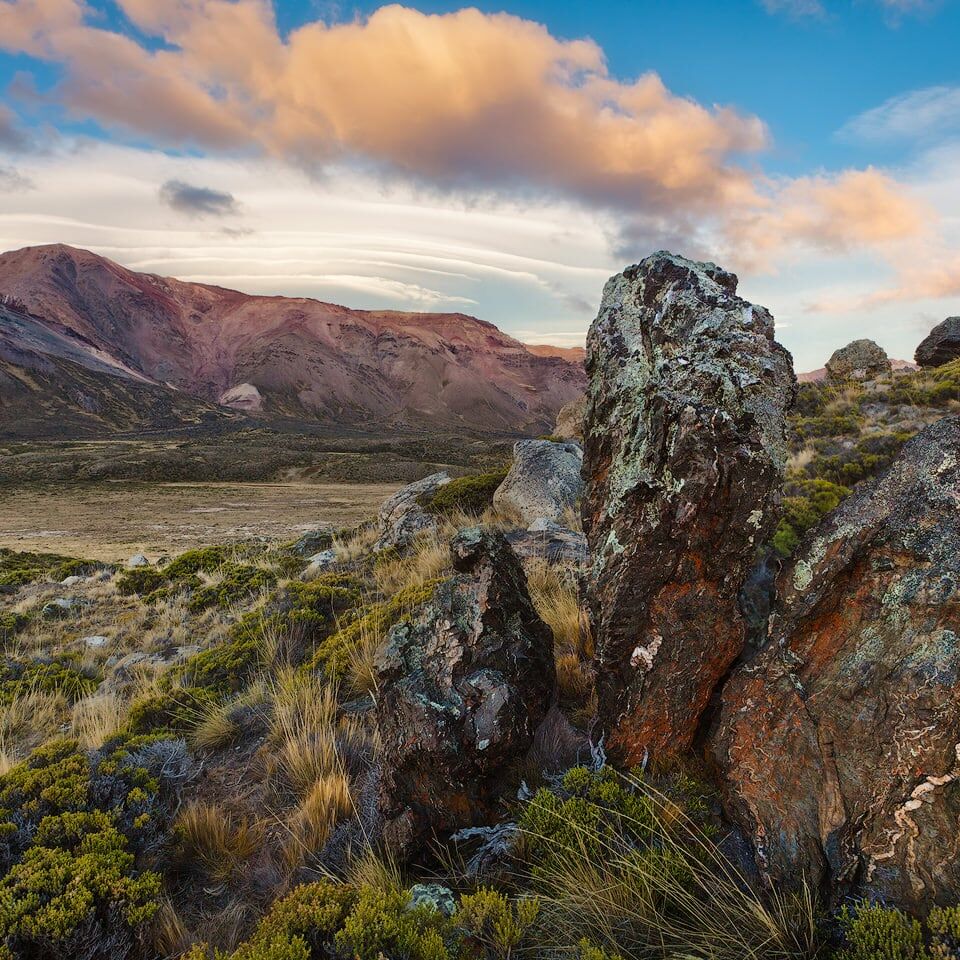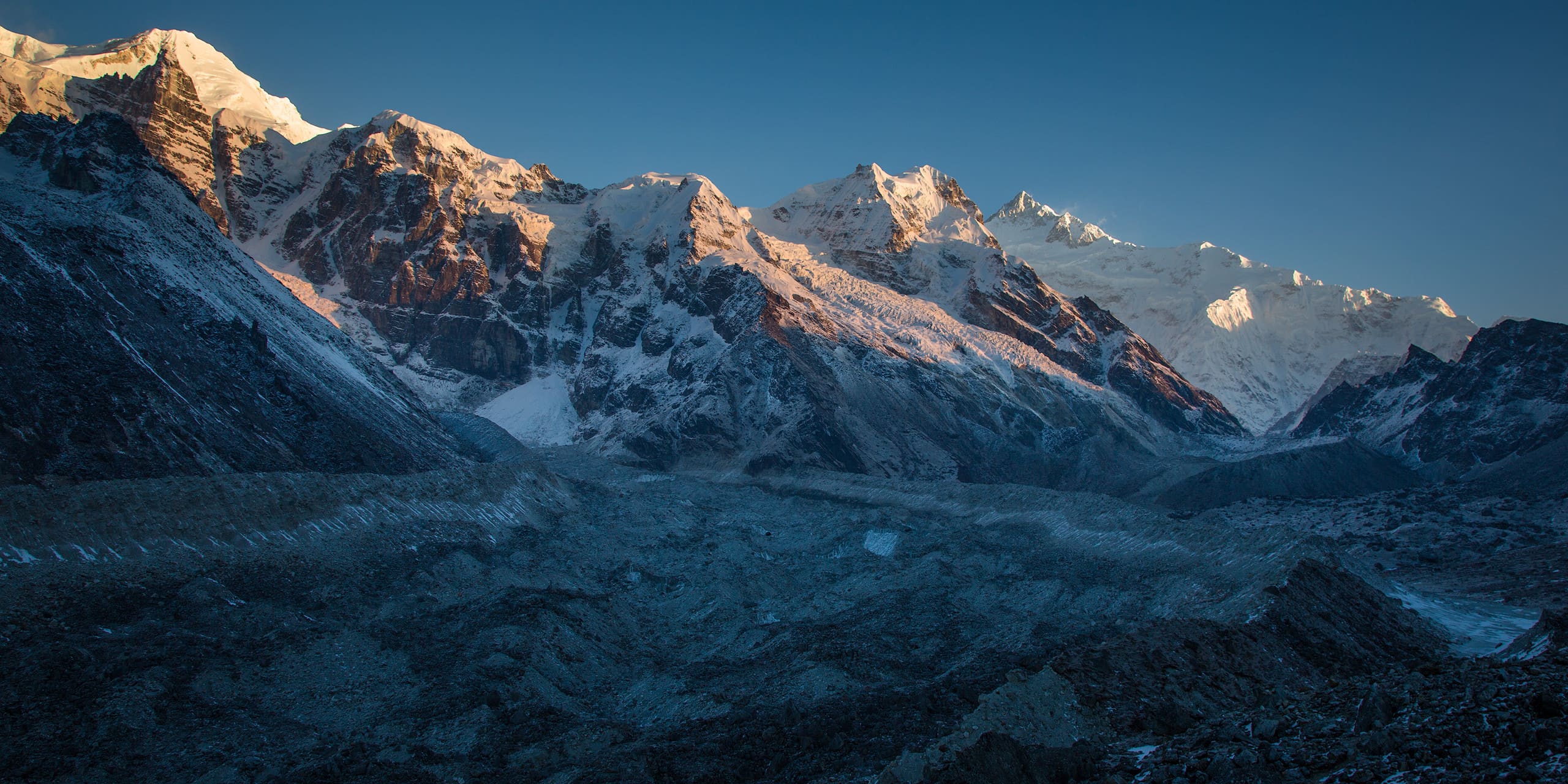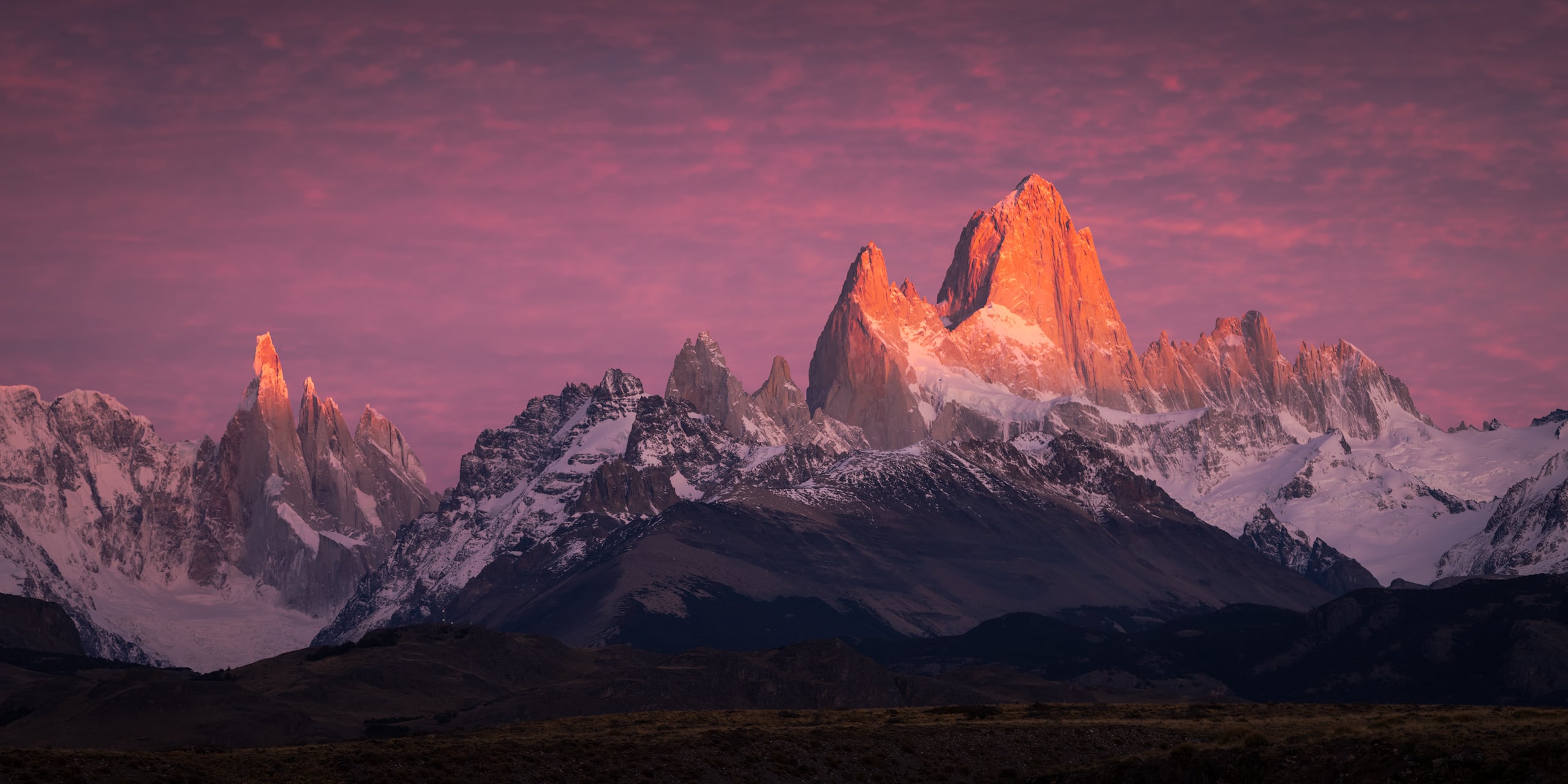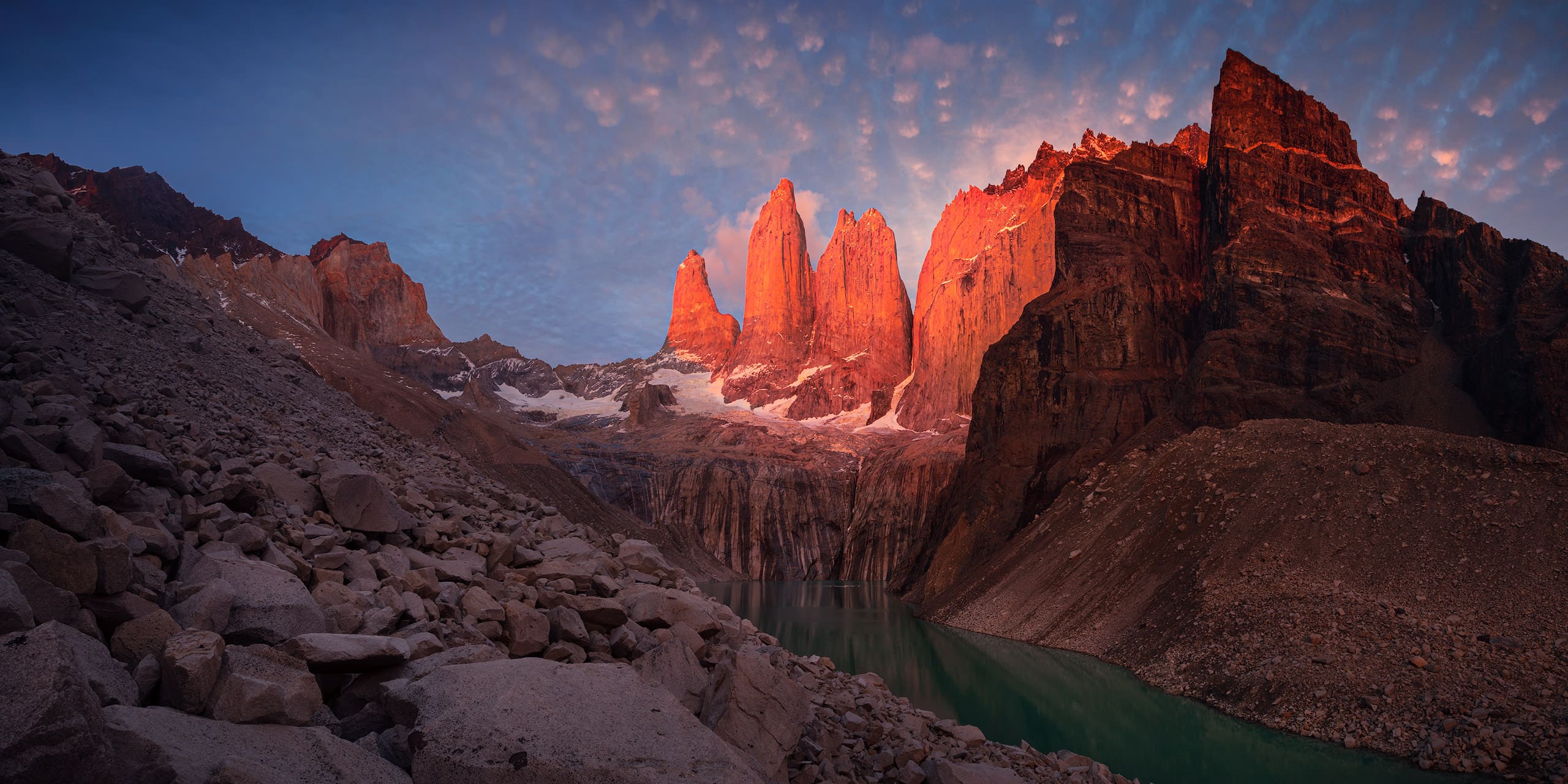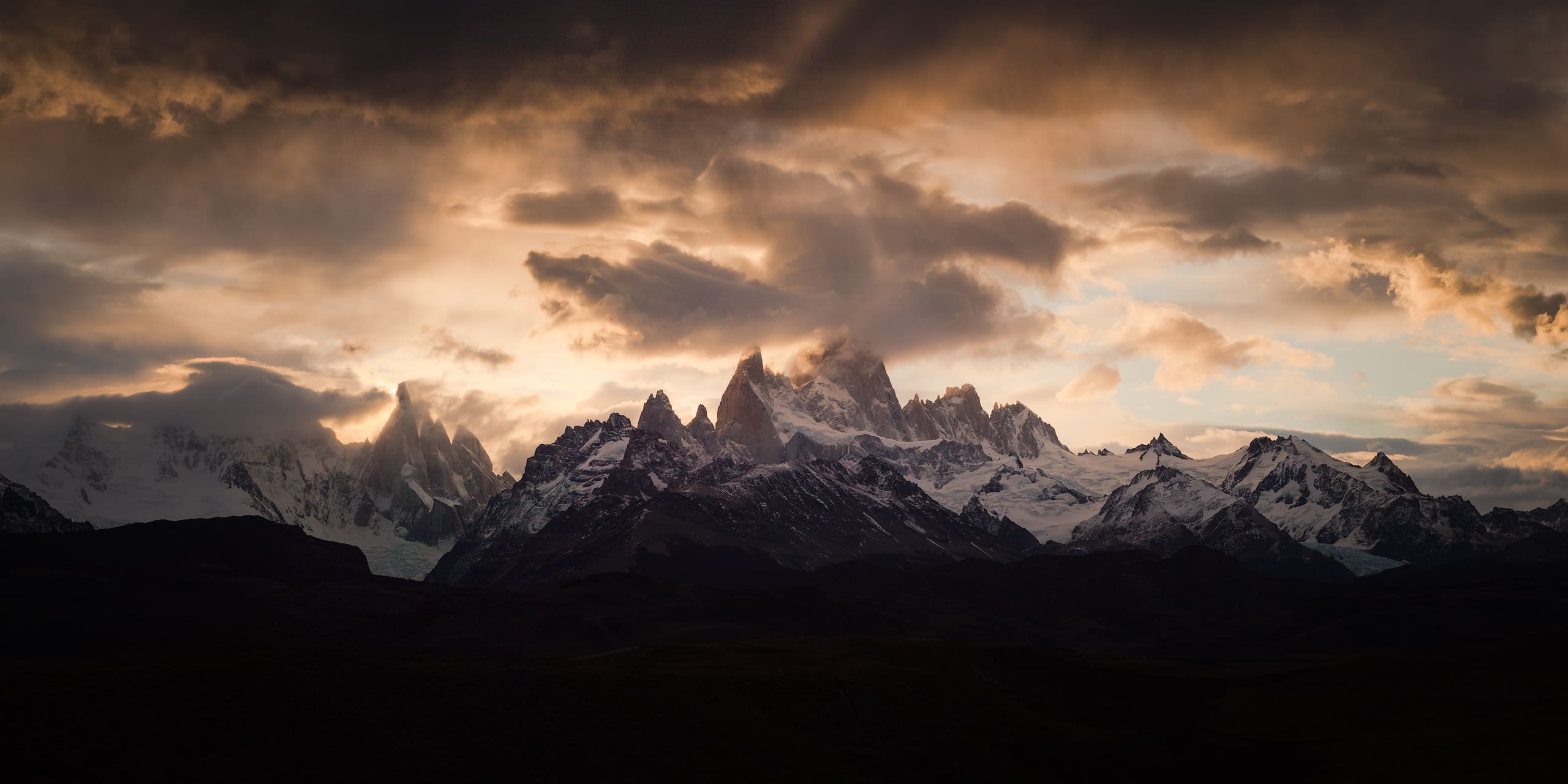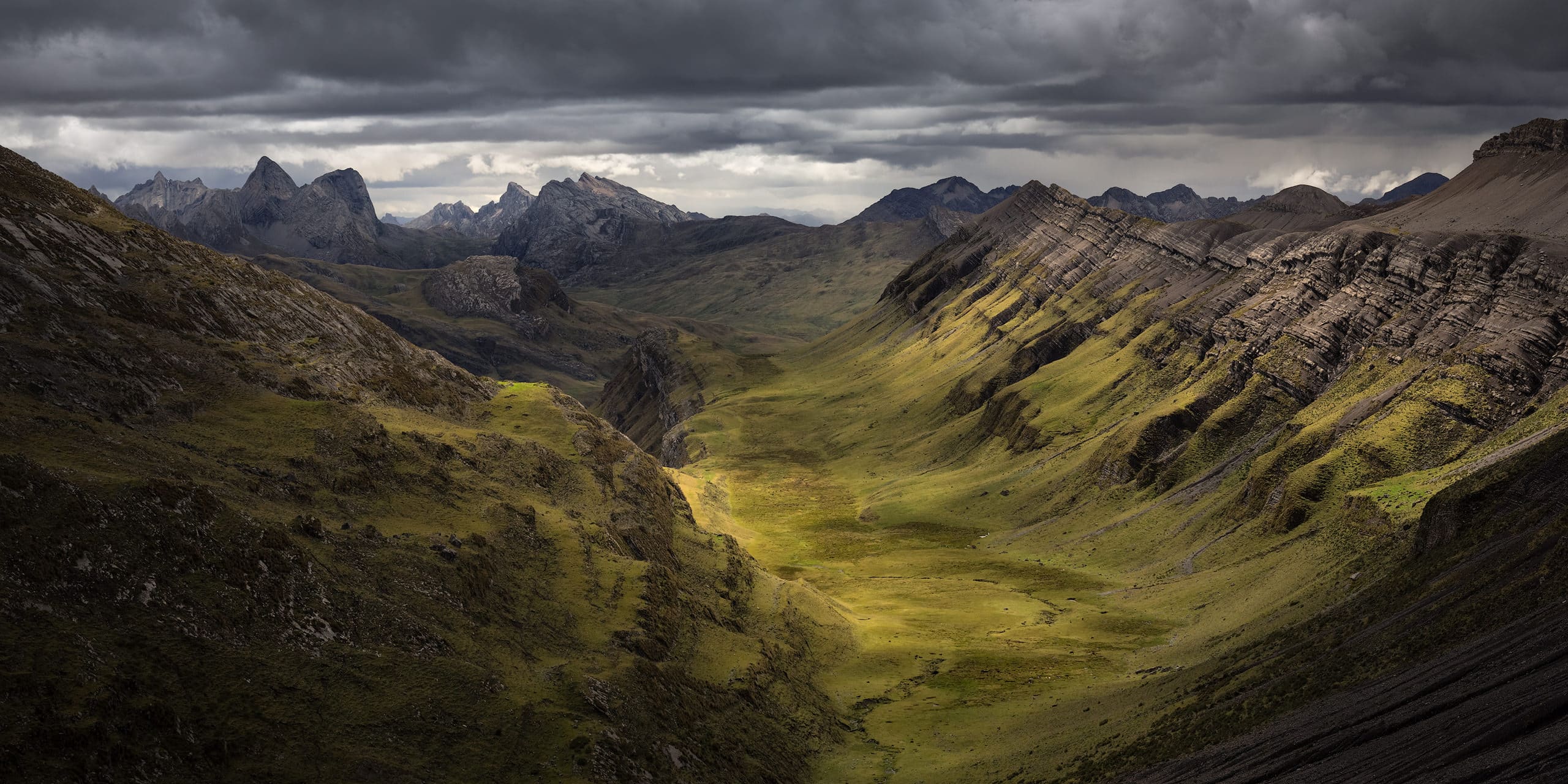Overview
Parque Nacional Perito Moreno (strictly speaking Parque y Reserva Nacional Perito Francisco P. Moreno) was created in 1937 in the west of Argentinian province of Santa Cruz on the border with Chile, with the aim of preserving the fauna, flora and archeological evidence found in the region. The park was named after Francisco “Perito” Moreno the prominent Argentinian geographer and explorer of Patagonia. Its protected area extends over 142.120ha in a zone where the Patagonian steppe is dotted with lagoons, Patagonian forests climb the mountain slopes to give way to rocky outcrops and ice-capped peaks, while lakes of glacial origin paint turquoise and emerald tones onto the landscape.
Few people visit the park and those who do, clearly seek adventure and solitude. Climbers are attracted by spectacular routes around Monte San Lorenzo and the surrounding valleys offer wilderness at its finest to anyone with an interest in Patagonian landscapes and their natural beauty, and is ready to deal with its remoteness.
The national park has a high scientific value due to the the natural aspects and paleontological evidence it protects. The park contains important evidence of the ancient human occupation of the region in the form of rock paintings and other archaeological remains dating back to almost 10.000 years ago. At that time the ancestors of the Tehuelches, an indigenous Patagonian tribe, lived there, but it is believed that they abandoned the place due to the extreme climate.
In 2013 Conservacion Patagonica, founded by Doug and Kris Tompkins, donated the lands of Estancia Ríncon to the national park system of Argentina. This former sheep farm at the foot of Monte San Lorenzo – the most Himalayan-like peak of all in Patagonia – is now also protected and administered by Parque Nacional Perito Moreno.
Although they share a name, Parque Nacional Perito Moreno has nothing to do with Glaciar Perito Moreno, the glacier in Parque Nacional los Glaciares.
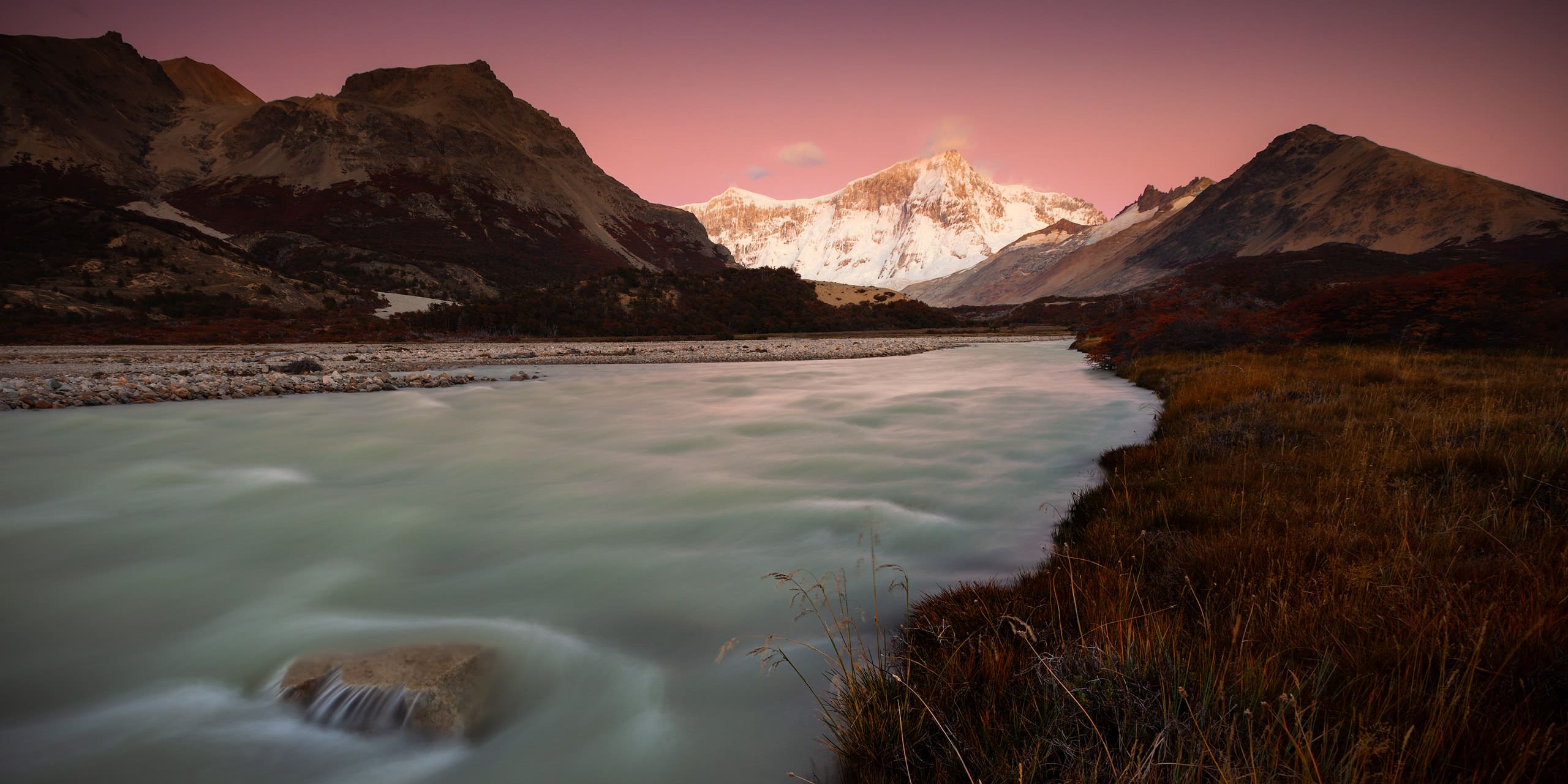

Parque Nacional Perito Moreno
Quick Info
In this section you’ll find a quick overview of the most important facts about Parque Nacional Perito Moreno together with a map and a few links. Scroll down for the travel guide to find out where to go and what to do! Even further down you’ll find sections covering trekking and landscape photography and an exclusive image gallery.
Facts
- Type: National Park
- Year of Creation: 1937
- Area: 142.120ha
Location
- Country: Argentina
- Province: Provincia de Santa Cruz
- Nearest Airport: El Calafate (FTE)
Parque Nacional Perito Moreno
On the Map
- GPS: 47°50'22.489'' S / 72°02'34.351'' W
- Lat/Long: -47.839580, -72.042875
Additional Information:
Travel Guide
In Parque Nacional Perito Moreno you can experience something more extreme than in the rest of Patagonia: the solitude, the nothingness, and the incredible extension of uninhabited land. Due to its remoteness, this wonderful place is still almost unexplored and to give you a vague idea of the solitude of this place let me tell you this: on my last visit in March 2015 I was told by the park rangers that at the time being, me and my companion were the only people in the park, and that the total number of visitors in that year had been just little over 900. Now, compare that to the 733.000 people who visited Parque Nacional los Glaciares in that same year.
Top Sights
Looking for ideas and things to do in Parque Nacional Perito Moreno? Here’s a selection of highlights which you definitely shouldn’t miss during your visit.
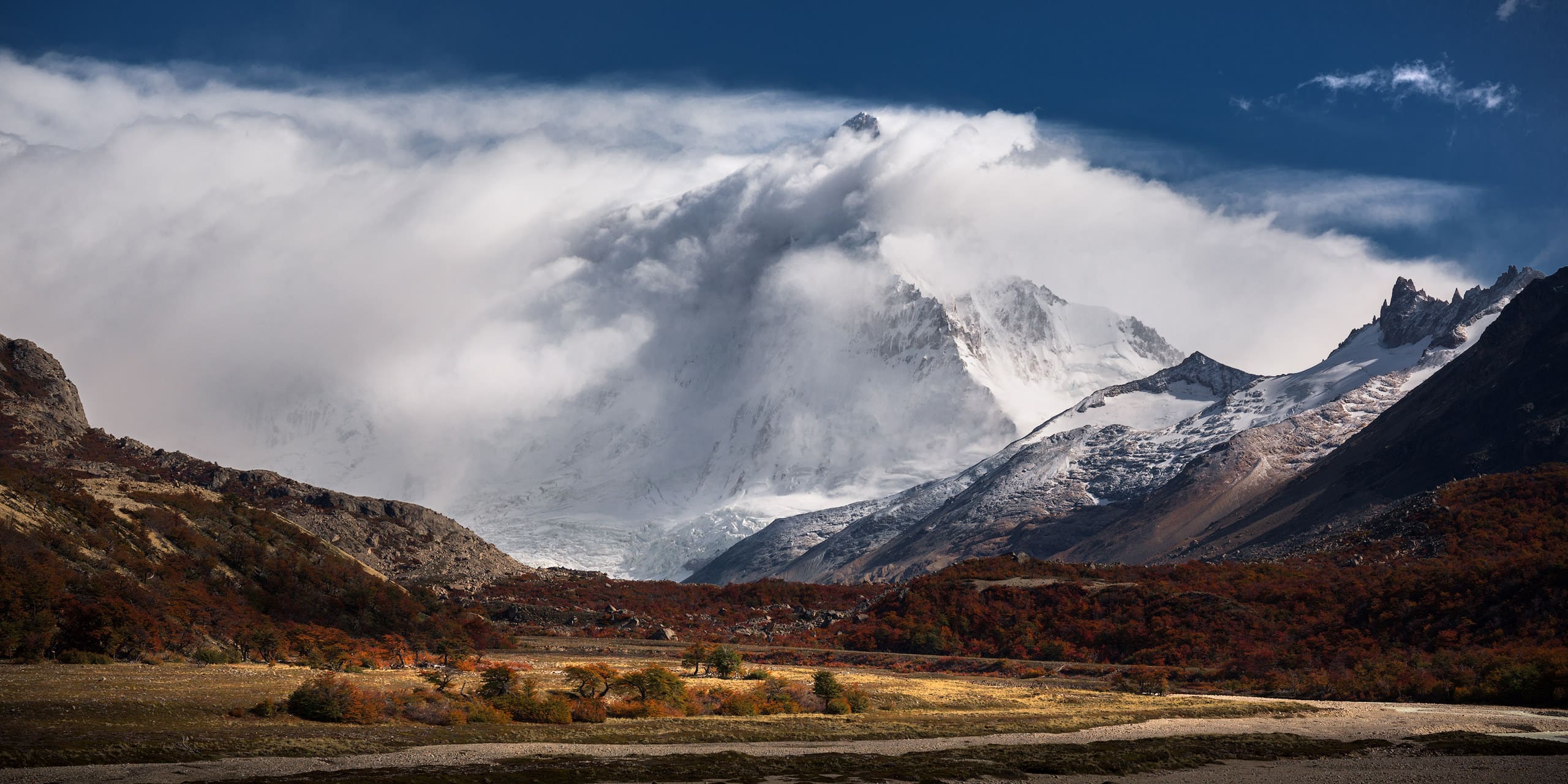
Monte San Lorenzo
Monte San Lorenzo stands as one of the most striking peaks in the Patagonian Andes, offering a remote and rugged adventure for mountaineers. Known for its rich climbing history and notorious unclimbed east face, this…
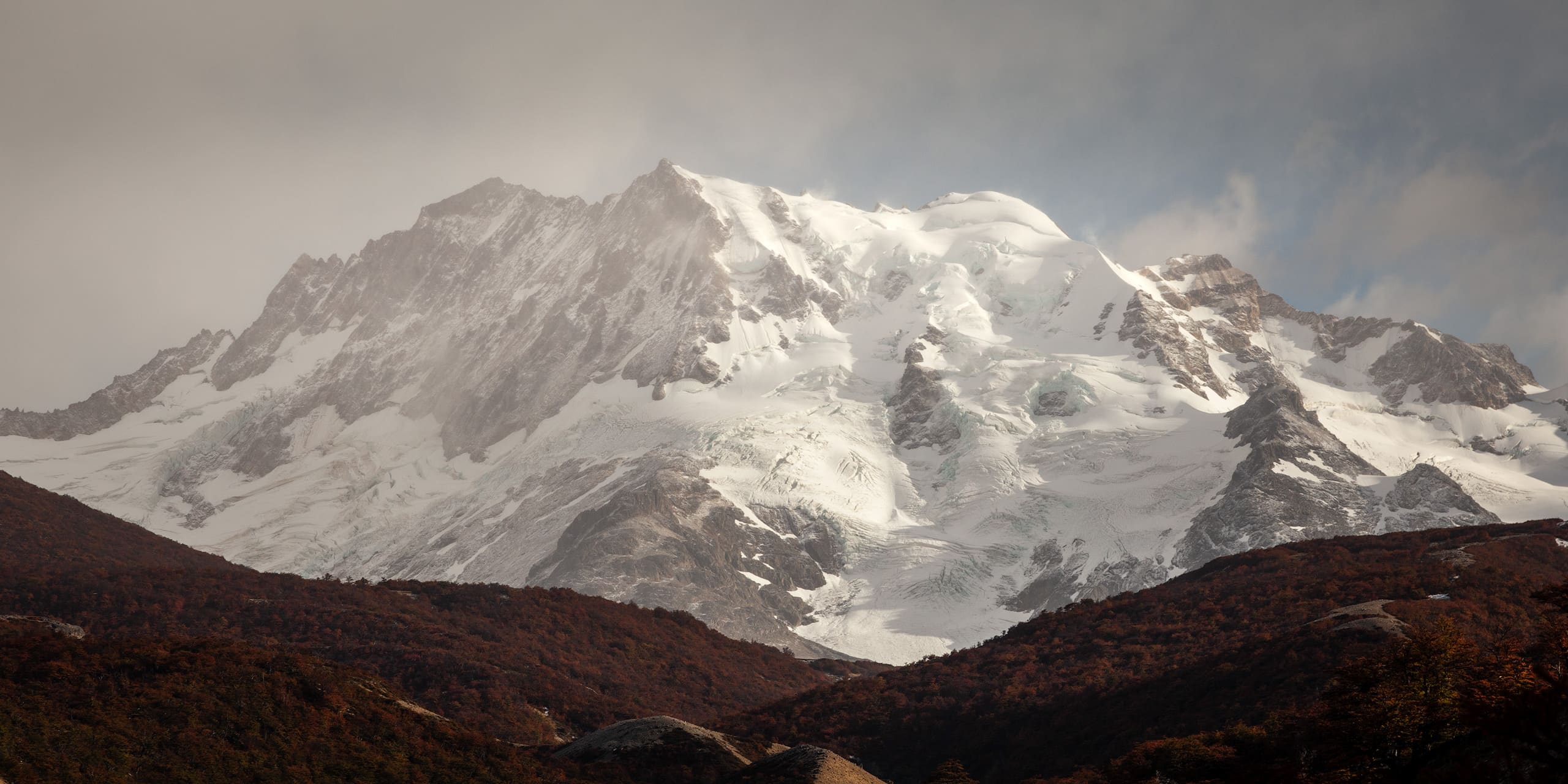
Cerro Hermoso
Cerro Hermoso is one of the more prominent peaks of Parque Nacional Perito Moreno. It lies north east of Monte San Lorenzo.
While it surely plays an important role, solitude is not the only thing that makes Parque Nacional Perito Moreno stand out amongst other national parks in Patagonia. The vast landscape is in a way rougher and more barren. There is less forest and bushland, instead you find open grassland and colourful rocks. The openness of the land allows for better wildlife spotting oportunities, but comes at the cost of less protection from the winds often howling at gale-force. Overall the elements feel even closer and more immediate here, than in any of the more popular parks in the south.
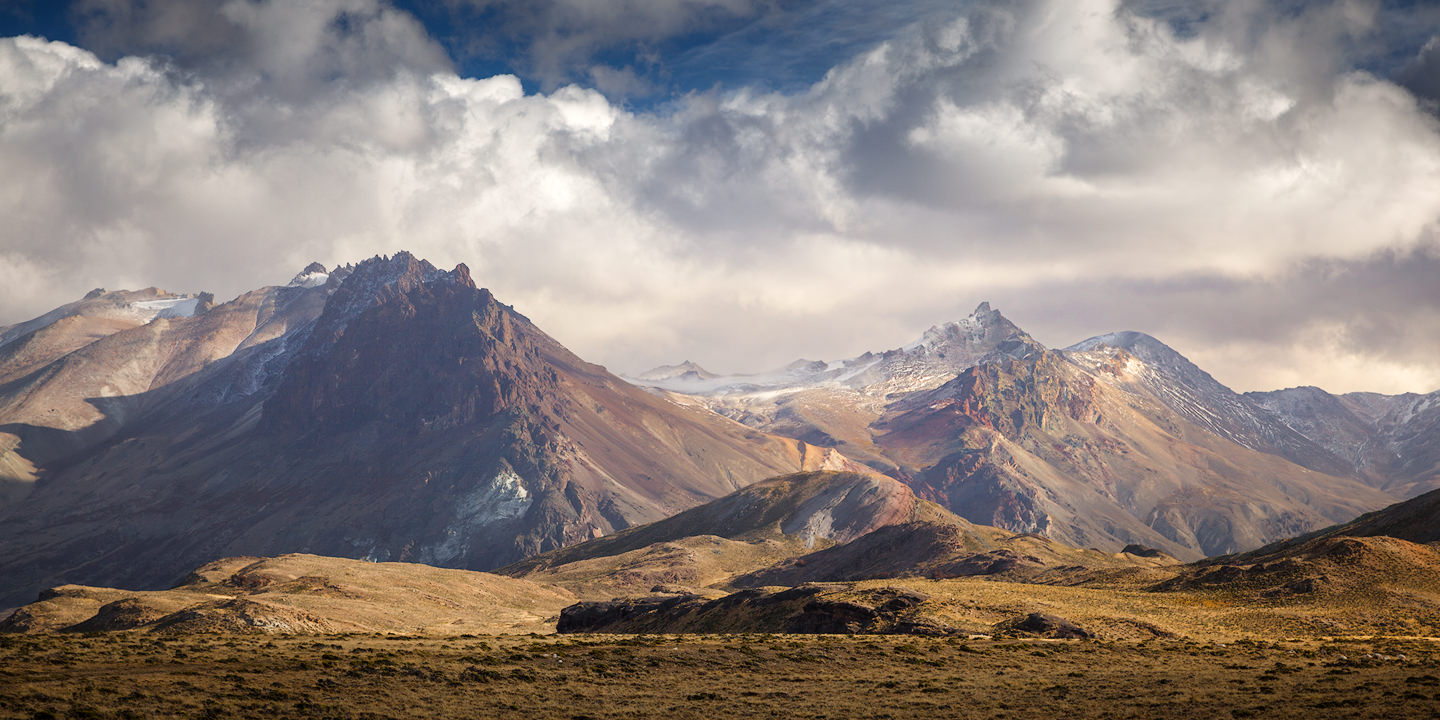
Another particularity of Parque Nacional Perito Moreno is that of the eight marvellous lakes in the park, only one drains into the Atlantic Ocean. The waters of seven of these lakes, Lago Belgrano, Lago Azara, Lago Mogote, Lago Nansen, Lago Volcán, Lago Península and Lago Escondido flow into the Pacific Ocean – only Lago Burmeister drains into the Atlantic, like most other lakes in Argentinian Patagonia.
What to do?
Given its attributes and remoteness, Parque Nacional Perito Moreno attracts adventurers and people with a genuine interest in Patagonian nature. Don’t expect to see party crowds or micro-influencers on the hunt for stories, like in other national parks in Patagonia or elsewhere in the world. It is a place where you just sit (or hike) and watch, and become one with nature and yourself. If you come here, take your time and don’t rush through – beauty is more subtle here and there’s more to see and feel than what might be obvious at first sight.
Please note: the opening hours of Parque Nacional Perito Moreno are from 9am to 9pm between October 1st and May 1st. All visitors must register with the park administration upon arrival. Registration can be made at the Onelli Visitor’s Center in the center of the park.
Hiking
The park has a network of trails of more than 100 kilometres that offer routes with different levels of difficulty and duration. The options range from easy day hikes with durations starting at less than an hour, all the way to extended multi-day backpacking trips. Always remember to inform yourself in advance and plan your itinerary according to your physical fitness and experience.
Birdwatching
One of the attractions of the national park is the great variety of birds (120 species) that find food, shelter and nesting sites in its beautiful lakes and streams. The Lagunas del Mié bird observatory is located about eight kilometres away from the Centro Operativo Onelli, on the way to Mirador del Lago Belgrano. From the observatory you will be able to watch and enjoy a variety of birds, such as flamingos, geese and ducks, without interfering with their natural behaviour, and sheltered from the wind. Keep an eye out for the mighty condor when on the move in the park.
Where to stay?
Apart from one private Estancia (see below), there is no accomodation in Parque Nacional Perito Moreno, and staying there means bringing your own tent, sleeping bag and food (and cooking for yourself for that matter). The park offers two basic campgrounds that can be reached by car – one at Seccional El Ríncon, the other at Lago Burmeister. Both have a few spaces for tents and one for a motorhome. Campsites have basic protection from the wind and basic (dry) toilets. Don’t expect to find a shower here.
The trail-network in the park has been upgraded with woooden cabins called refugios. All huts offer protection from the elements and are equipped with a low-consuption wood stove, cushions and basic dishes. Use of cooking stove is still mandatory. Each trail offers between 2-4 of those huts, which can be used for a maximum of two nights and have to be reserved through the national park administration. Be early – the refugios sometimes are booked for weeks in advance. Some of the cabins also have a few campsites next to them. See below for a list of refugios associated with each of the three main trail areas.
Circuito Azara
- Refugio René Negro - 3 cabin beds + 3 campsites
- Refugio Tucúquere - 3 cabin beds + 3 campsites
- Refugio Azara - 6 cabin beds
- Refugio La Angostura - 3 cabin beds + 3 campsites
Circuito Península Belgrano
- Refugio Caleta Huala - 6 cabin beds
- Refugio Archipiélago - 6 cabin beds + 3 campsites
- Refugio Dos Bahías - 6 cabin beds + 3 campsites
- Refugio Playa Quetro - 3 cabin beds + 3 campsites
Circuito Valle del Río Lácteo y Laguna los Témpanos
- Refugio Gilberto - 6 cabin beds
- Refugio Doug y Kris Tompkins - 3 cabin beds + 3 domos + 12 campsites
If you are looking for an even more solid and comfortable option you might try Estancia La Oriental which is located inside the park and offers a rural Patagonian expierence: accomodation in rooms with shared or private bathroom, food, camping and excursions in- and outside the national park. Estancia La Oriental is the only privately run accomodation in the park.
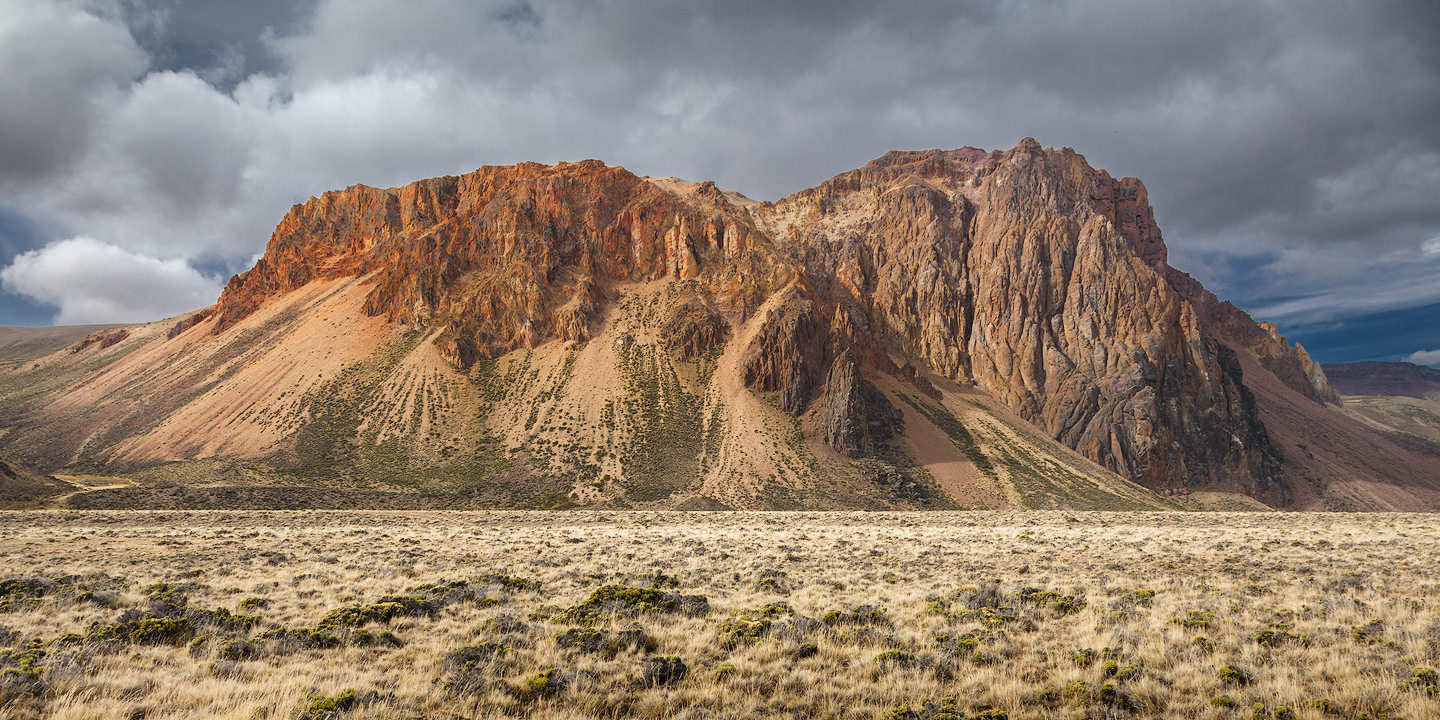
How to get there?
Forget everything you have learned about ease of transport in other parts of Patagonia (like Parque Nacional los Glaciares or Parque Nacional Torres del Paine) – getting to Parque Nacional Perito Moreno involves quite a bit more. The sheer distances are overwhelming, and the absence of public transport into the park makes it difficult to get there. I recommend viewing the way to the park as part of the adventure, and to not take it too lightly – you might even get stuck on the way. Especially the last stretch into the park sees little traffic. Offer your help if you encounter someone who might need it.
Getting to Perito Moreno National Park
Your best (or only?) chance is using your own car, but even that comes with a caveat: there’s no fuel available in a radius of 200km.
Parque Nacional Perito Moreno can be reached via the Ruta Nacional 40 (the famous Ruta 40) which then connects with Ruta Provincial 37. The nearest towns are Gobernador Gregores in the southeast (distance 200km) and Perito Moreno in the north (distance 320km). Be warned – the last 90km on RP37 are a gravel road. The closet reliable gas station can be found in Gobernador Gregores – Bajo Caracoles (185km) to the north offers a gas station as well, but don’t be surprised if you find it closed or empty. Bring spare fuel and tires! Take into account the weather conditions along the drive (winds can be furious).
There is no public transport or bus available to get you into park. Gobernador Gregores can be reached by bus from Río Gallegos or El Calafate (which have air connections with Buenos Aires) and from Puerto San Julián or Comandante Luis Piedra Buena, which receive buses from almost all over the country. From Gobernador Gregores you would have to continue by your own means or by hiring a taxi or a remís.
Distances inside the park are quite long and even if you make it there, you’d be very limited without having your own car. The park has a total of 90km of roads within its borders. Even to get to some of the trail-heads you will have to drive between 10-20km. Keep that in mind when making your fuel calculations.
Trekking
The protected area of Parque Nacional Perito Moreno has more than 100 kilometres of trails through which you can walk and discover the wonders hidden in one of the wildest national parks in Patagonia. Most of the trails have been recently built with gentle slopes and based on sustainable design principles so that they can be enjoyed by families as well as by experienced hikers. There are short trails, which require only a few hours to hike, and longer trails that can take 2-5 days to complete. The latter have shelters and camping areas strategically located to make it easier for visitors.
The biggest difference to other national parks in Patagonia is that you will most likely be walking on your own. The low number of visitors guarantees an unspoilt and raw experience, making trekking in the park a fascinating adventure, serving as a reminder how small we humans are. Get ready for an unforgettable trip through these rugged landscapes that eventually might have you philosophying about life.
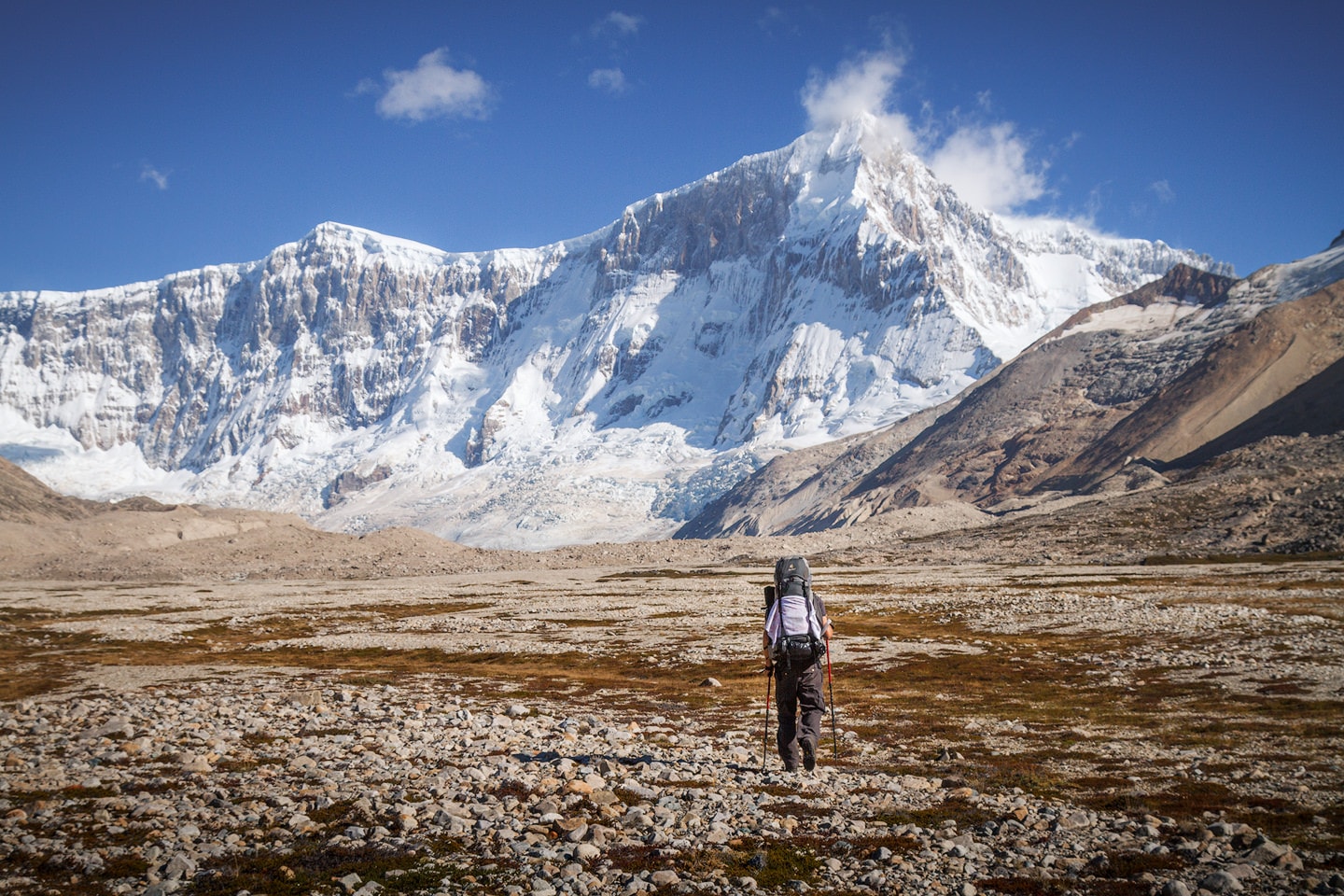
Not only will hiking get you up close and personal with the pristine nature of the park, it will also take you on a tour through some important Patagonian ecosystems. Most trails start in the Patagonian Grassland, a desert-like landscape with grasses and scattered shrubs. The further west you go, the more you’ll be walking through Lenga forests. Above the treeline you’ll encounter alpine surroundings where vegetation becomes scarce, as rocks and ice take over.
There’s many things to see around here and it is recommended to keep your eyes open during your hikes in Parque Nacional Perito Moreno, as you might come across some of Patagonia’s wildlife. It is almost impossible to visit the park without seeing some of the most common bird species like flamingoes, the Austral parakeet, the Magellanic woodpecker or even an Andean condor. The most common mammals are Guanacos, the Andean Grey Fox, the elusive Puma and a few other, smaller Patagonian rodents and wildcats.
Popular Hikes
The newly built trail system in the park offers keen hikers and adventurers quite a few options to choose from. Ask at Onelli Information Center for more trails and maps. Here’s a small selection:
Circuito Península Belgrano
Beautiful hike across the gentle landscape of Península Belgrano offering spectacular views of Lago Belgrano and the surrounding hills. One of the most striking aspects of this lake is its unique colouring, which gradually changes from its northern to its southern end. There are two circuits sharing the beginning and end; the difference being that the small circuit crosses the centre of the peninsula, while the large circuit runs more or less along its western and southern shores.
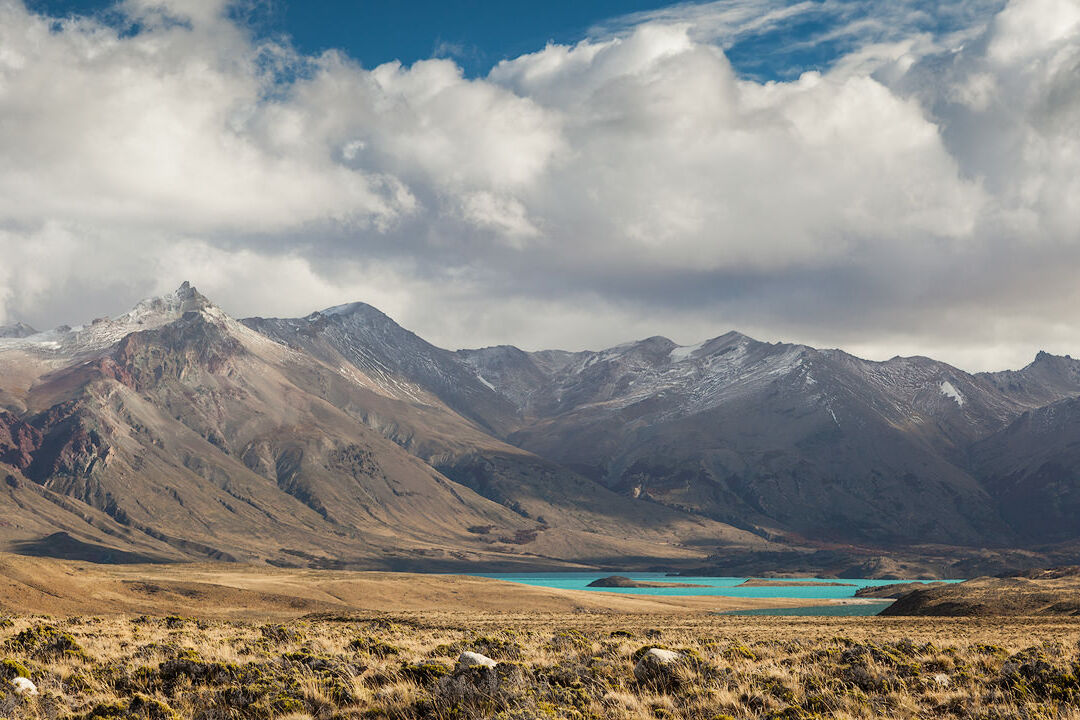
- Distance: 19km (round trip)
- Duration: 1-2 days (round trip)
- Max. elevation: 930m
- Level: intermediate
- Registration: necessary
Circuito Valle del Río Lácteo & Laguna de los Témpanos
Takes you through the valley of the Río Lácteo to the base of Monte San Lorenzo. At the end of this trail you reach the Refugio Doug & Kris Tompkins and the rustic Puesto San Lorenzo, an old wooden hut. This is my favourite trail in the park – check out this little write up from my first trip there (before the trail and refugio had been built). Come prepared for crossing rivers.
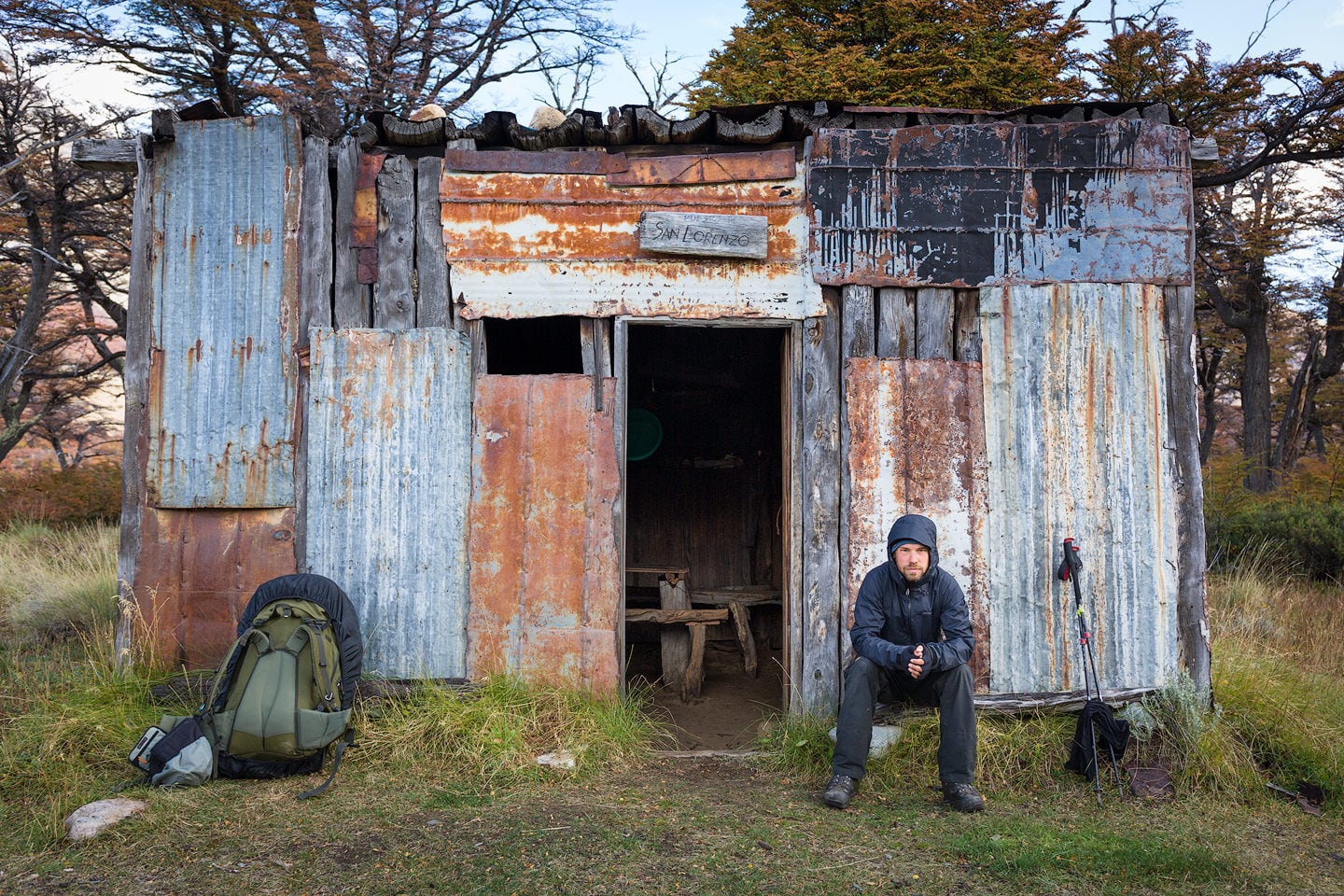
- Distance: 35km (round trip)
- Duration: 2-3 days (round trip)
- Max. elevation: 1171m
- Level: advanced
- Registration: necessary
Cerro Léon
The trail to Cerro Léon is a moderate (but demanding) walk to a central viewpoint in the park. Enjoy the epic views of Valle del Río Lácteo and Cerro Volcán in the north and the turquoise waters of Lago Belgrano in the south. It can be accessed from El Rincón Camping Area or from the vicinity of Estancia La Oriental (the latter being considerably longer).
- Distance: 6km (round trip from El Rincón)
- Duration: 2-3 hours (round trip)
- Max. elevation: 1405m
- Level: intermediate
- Registration: necessary
Circuito Azara
This trail crosses from the grasslands to the lenga forests of the Azara sector and offers extensive views of the surrounding lakes and mountains. Although the trail itself isn’t that tough, the circuit as a whole is quite demanding due to its total distance and the time it takes to complete. It starts at the Azara car park in the south of the park.
- Distance: 91km (round trip)
- Duration: 3-5 day (round trip)
- Max. elevation: 977m
- Level: advanced
- Registration: necessary
Advice for Hikers
Weather & Climate
Before going on a hike in this part of the world, you should know a few things about weather in Patagonia. First of all: Patagonia can give you basically three seasons in one day, which means: sun, rain and snow. Weather is very unpredictable and can change quickly. Plus: don’t be surprised if you find yourself battling 100+ km/h winds. It’s best to check a reliable weather forecast (locals use Windguru, which also worked well for me in the past), to get a rough idea what to expect. But in any case: be prepared for everything.
The summer season in the park lasts roughly from December to February and offers the warmest temperatures. On sunny days with little wind you might be on the trail in a t-shirt and shorts. Nights can get frosty in shoulder season (October, April), but the notorious wind should be less of a nuisance. Have in mind that Parque Nacional Perito Moreno lies at a higher altitude than the popular national parks in southern Patagonia. Climate is considerably colder. Also, there is not as much protection from the wind as you might wish for.
Trails & Safety
As long as you stick to the newly built trails you can expect well marked trails and comfortable hiking. There’s a sign at most important intersections, and bridges facilitate the crossing of streams. Refugios and camps were established in safe zones with easy access to water. Water is available throughout most of the hikes and usually of excellent quality. That said, it is still recommended to take smart decisions about where to get your water from, especially around campsites.
But don’t take it too lightly – Parque Nacional Perito Moreno (and especially the area around Laguna de los Témpanos) is a remote alpine environment with all its beauty but also dangers. Expect having to wade through rivers, strong winds and quickly changing weather there. Ask the park rangers for any updates on trail conditions. Stick to the rules, acknowledge red tape, and as always it’s highly recommended to be aware of your own skills and the environment you move in. It is essential that you plan an appropriate itinerary for your physical experience and carry the indicated equipment. Remember that the park is very isolated and the distances to nearby towns are long. Please also note, that there is no cell phone service anywhere near the park. In case of an emergency, help might be days away.
Keep in mind that the park is the natural habitat of the Puma. Luckily sightings or attacks are rare, as the South American Puma is shier than its North American relative, the Cougar (well, actually the Puma is just lucky enough to find sufficient prey further away from humans). Still, it is recommended not to walk alone, and never leave children unattended. In case of an encounter with a Puma, do not panic or run. Try to appear bigger and taller – rise your arms up, maybe hold up your walking sticks. Don’t crouch or bend over. Move away slowly, always facing the Puma – don’t turn away.
Camping
Camping in Parque Nacional Perito Moreno is free and widely available in the center of the park and along the trail network. The wooden refugios usually also offer a few campsites. Bring a sturdy tent, and prepare for strong winds. It is probably wise to check with the park’s administration before leaving, as there is a reservation system for the refugios which might affect the availability of campsites as well. As usual in Patagonia: NO FIRES ALLOWED!
Supplies & Equipment
There is no food or any other supplies available in the national park. Bring (more than) enough food, fuel and everything else you might need. The nearest supermarket, restaurants and gas station can be found in Gobernador Gregores more than 200km or a three-and-a-half-hour drive away.
Fees & Permits
At the time of writing, access to Parque Nacional Perito Moreno is free. All visitors must register with the park’s administration at Onelli Visitor’s Center after entering the Park. For the use of the cabins a reservation in advance is needed.
Landscape Photography
If you’ve had enough of all the iconic and over-popular locations in the other national parks of Patagonia (like Parque Nacional Torres del Paine or Parque Nacional los Glaciares), landscape photography in Parque Nacional Perito Moreno might be what you are looking for. Here you get similar landscapes (well, maybe a bit rougher) and light, but don’t be surprised if you’re the only photographer within a radius of 300km. As always in Patagonia, the ever changing weather and incredible cloud formations (lenticular clouds are quite common) hold surprises for every sunrise or sunset.
If there’s something like an icon in the park, it’s probably Monte San Lorenzo – but, getting to the base of the mountain is quite an adventure, that keeps many people away. Make sure to bring a light and sturdy tripod, and enough ND filters to shoot long exposures of streams and lakes. Wide angles work wonders on compositions, but don’t underestimate the power of a close-up shot with a tele lens. Creativity is only limited by your own imagination and capacity to get to places.
Image Gallery
A picture says more than a thousand words they say – check out my image gallery of Parque Nacional Perito Moreno below. I took these images during two stays in the park over the course of three years. Most of them have been taken in the area around the Río Lácteo Valley and Monte San Lorenzo. Click on the images to open a lightbox.
On the Blog
We are not done yet. If you want to read more about Parque Nacional Perito Moreno and keep exploring the blog, you’ve come to the right place. Here’s a selection of related images, adventures and articles from my blog for you:
The last news about Patagonia that made it into austrian newspapers was when a tourist accidentially set Torres del Paine National Park on fire in December…
It's a remote, but incredibly beautiful mountain and has a massive, unclimbed east face - that's more or less all I could find out about Cerro San Lorenzo…
After returning from our first trip to Patagonia I somehow had the feeling that I had to go back. We had seen a lot, but I felt there was so much more. Even…
